Tourism and Its Impact
VerifiedAdded on 2020/01/23
|15
|6343
|389
Essay
AI Summary
This assignment delves into the multifaceted realm of tourism, examining its influence on economies, environments, and societies. It requires an analysis of the sector's economic significance, environmental footprint, and social implications. Furthermore, students are expected to evaluate promotional strategies employed in the tourism industry and discuss the importance of sustainable practices for long-term viability.
Contribute Materials
Your contribution can guide someone’s learning journey. Share your
documents today.
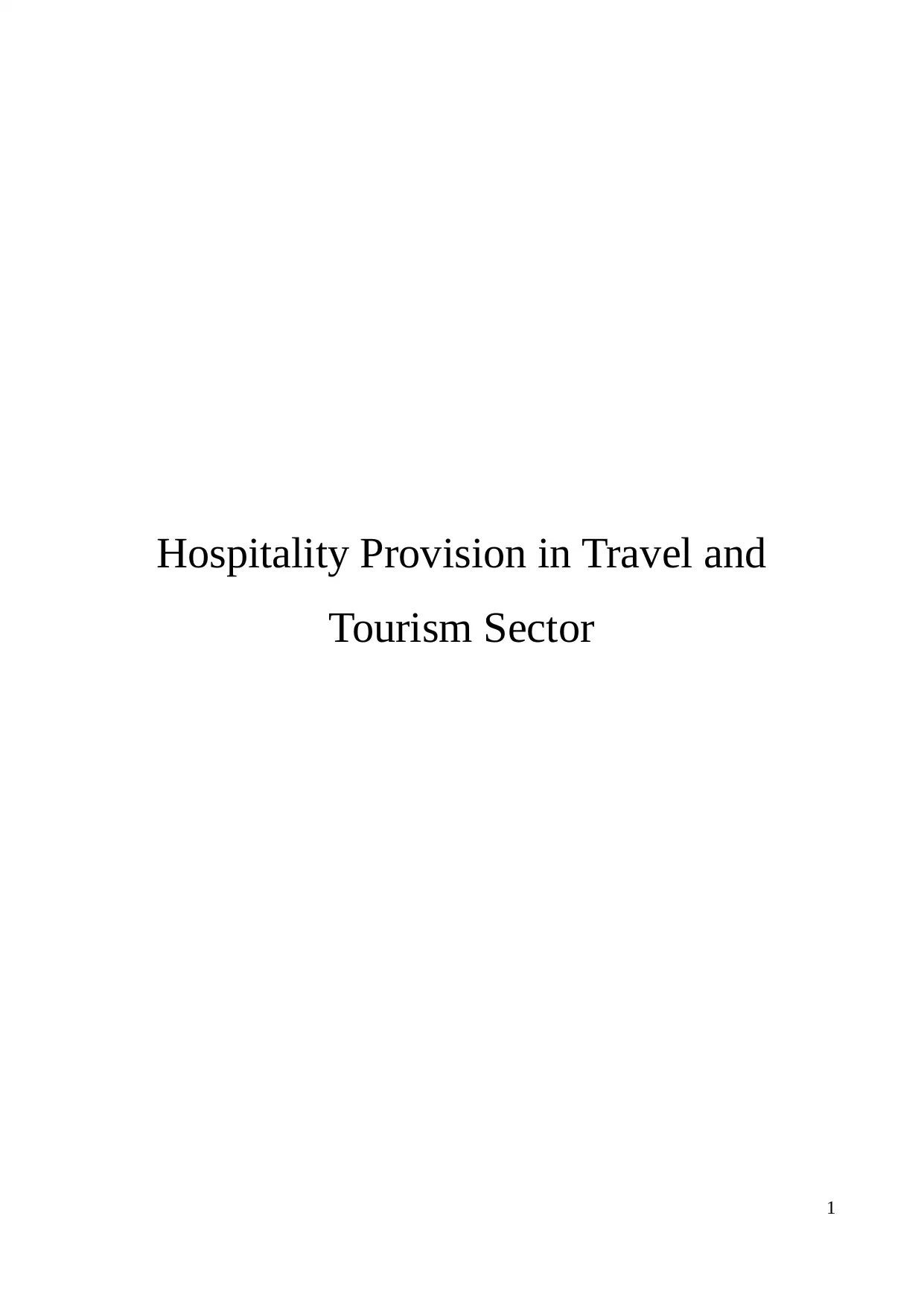
Hospitality Provision in Travel and
Tourism Sector
1
Tourism Sector
1
Secure Best Marks with AI Grader
Need help grading? Try our AI Grader for instant feedback on your assignments.
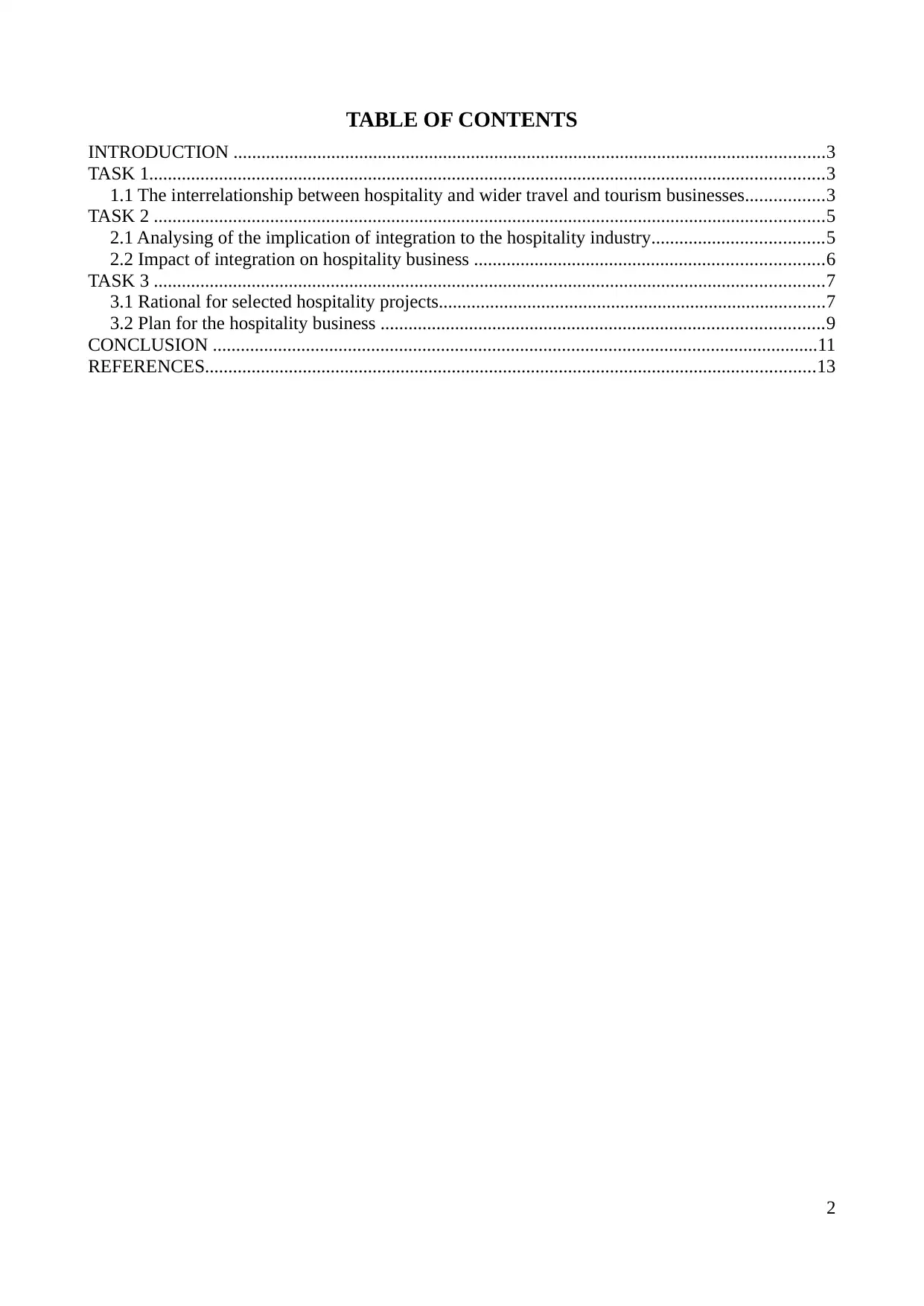
TABLE OF CONTENTS
INTRODUCTION ...............................................................................................................................3
TASK 1.................................................................................................................................................3
1.1 The interrelationship between hospitality and wider travel and tourism businesses.................3
TASK 2 ................................................................................................................................................5
2.1 Analysing of the implication of integration to the hospitality industry.....................................5
2.2 Impact of integration on hospitality business ...........................................................................6
TASK 3 ................................................................................................................................................7
3.1 Rational for selected hospitality projects...................................................................................7
3.2 Plan for the hospitality business ...............................................................................................9
CONCLUSION ..................................................................................................................................11
REFERENCES...................................................................................................................................13
2
INTRODUCTION ...............................................................................................................................3
TASK 1.................................................................................................................................................3
1.1 The interrelationship between hospitality and wider travel and tourism businesses.................3
TASK 2 ................................................................................................................................................5
2.1 Analysing of the implication of integration to the hospitality industry.....................................5
2.2 Impact of integration on hospitality business ...........................................................................6
TASK 3 ................................................................................................................................................7
3.1 Rational for selected hospitality projects...................................................................................7
3.2 Plan for the hospitality business ...............................................................................................9
CONCLUSION ..................................................................................................................................11
REFERENCES...................................................................................................................................13
2
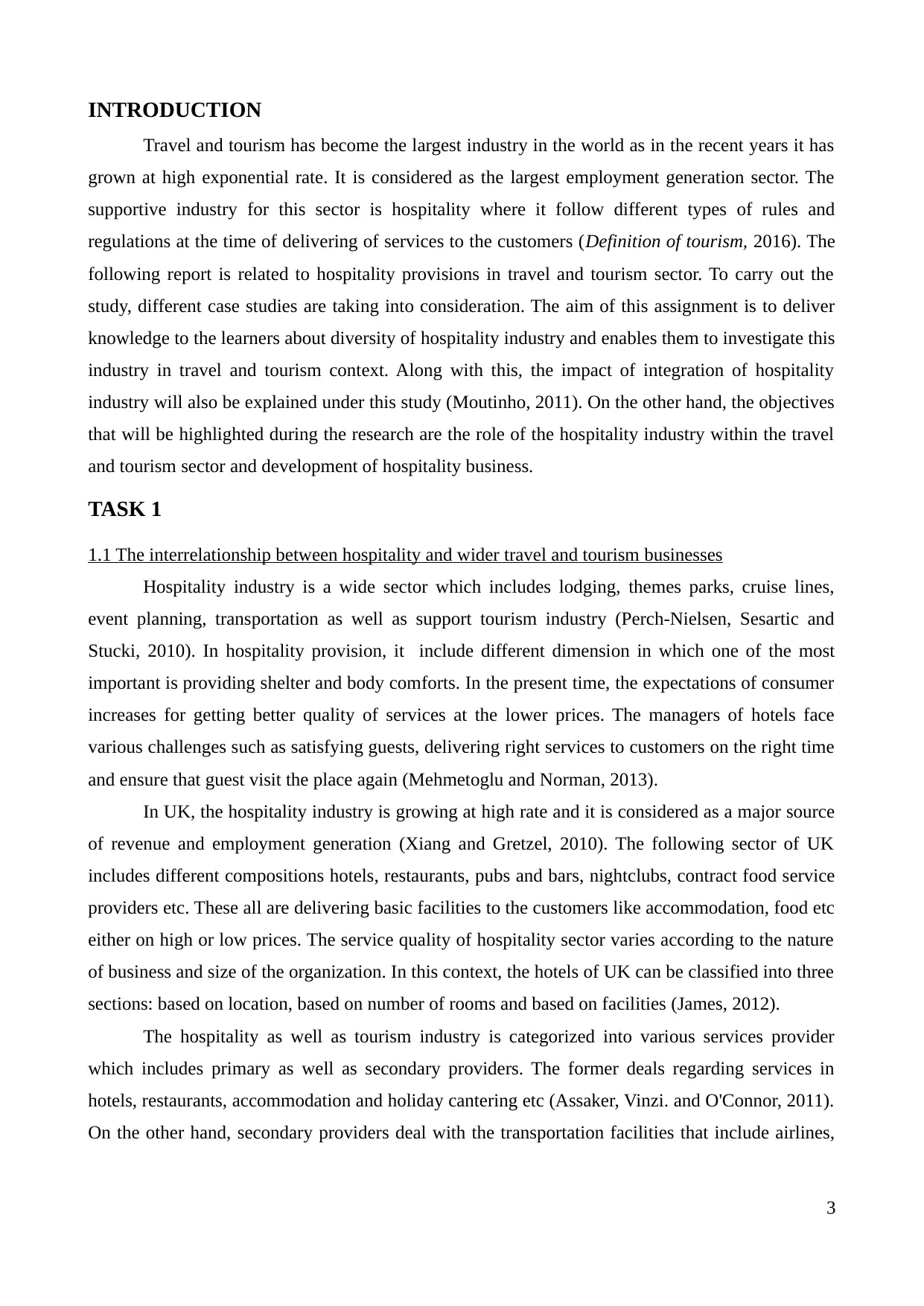
INTRODUCTION
Travel and tourism has become the largest industry in the world as in the recent years it has
grown at high exponential rate. It is considered as the largest employment generation sector. The
supportive industry for this sector is hospitality where it follow different types of rules and
regulations at the time of delivering of services to the customers (Definition of tourism, 2016). The
following report is related to hospitality provisions in travel and tourism sector. To carry out the
study, different case studies are taking into consideration. The aim of this assignment is to deliver
knowledge to the learners about diversity of hospitality industry and enables them to investigate this
industry in travel and tourism context. Along with this, the impact of integration of hospitality
industry will also be explained under this study (Moutinho, 2011). On the other hand, the objectives
that will be highlighted during the research are the role of the hospitality industry within the travel
and tourism sector and development of hospitality business.
TASK 1
1.1 The interrelationship between hospitality and wider travel and tourism businesses
Hospitality industry is a wide sector which includes lodging, themes parks, cruise lines,
event planning, transportation as well as support tourism industry (Perch-Nielsen, Sesartic and
Stucki, 2010). In hospitality provision, it include different dimension in which one of the most
important is providing shelter and body comforts. In the present time, the expectations of consumer
increases for getting better quality of services at the lower prices. The managers of hotels face
various challenges such as satisfying guests, delivering right services to customers on the right time
and ensure that guest visit the place again (Mehmetoglu and Norman, 2013).
In UK, the hospitality industry is growing at high rate and it is considered as a major source
of revenue and employment generation (Xiang and Gretzel, 2010). The following sector of UK
includes different compositions hotels, restaurants, pubs and bars, nightclubs, contract food service
providers etc. These all are delivering basic facilities to the customers like accommodation, food etc
either on high or low prices. The service quality of hospitality sector varies according to the nature
of business and size of the organization. In this context, the hotels of UK can be classified into three
sections: based on location, based on number of rooms and based on facilities (James, 2012).
The hospitality as well as tourism industry is categorized into various services provider
which includes primary as well as secondary providers. The former deals regarding services in
hotels, restaurants, accommodation and holiday cantering etc (Assaker, Vinzi. and O'Connor, 2011).
On the other hand, secondary providers deal with the transportation facilities that include airlines,
3
Travel and tourism has become the largest industry in the world as in the recent years it has
grown at high exponential rate. It is considered as the largest employment generation sector. The
supportive industry for this sector is hospitality where it follow different types of rules and
regulations at the time of delivering of services to the customers (Definition of tourism, 2016). The
following report is related to hospitality provisions in travel and tourism sector. To carry out the
study, different case studies are taking into consideration. The aim of this assignment is to deliver
knowledge to the learners about diversity of hospitality industry and enables them to investigate this
industry in travel and tourism context. Along with this, the impact of integration of hospitality
industry will also be explained under this study (Moutinho, 2011). On the other hand, the objectives
that will be highlighted during the research are the role of the hospitality industry within the travel
and tourism sector and development of hospitality business.
TASK 1
1.1 The interrelationship between hospitality and wider travel and tourism businesses
Hospitality industry is a wide sector which includes lodging, themes parks, cruise lines,
event planning, transportation as well as support tourism industry (Perch-Nielsen, Sesartic and
Stucki, 2010). In hospitality provision, it include different dimension in which one of the most
important is providing shelter and body comforts. In the present time, the expectations of consumer
increases for getting better quality of services at the lower prices. The managers of hotels face
various challenges such as satisfying guests, delivering right services to customers on the right time
and ensure that guest visit the place again (Mehmetoglu and Norman, 2013).
In UK, the hospitality industry is growing at high rate and it is considered as a major source
of revenue and employment generation (Xiang and Gretzel, 2010). The following sector of UK
includes different compositions hotels, restaurants, pubs and bars, nightclubs, contract food service
providers etc. These all are delivering basic facilities to the customers like accommodation, food etc
either on high or low prices. The service quality of hospitality sector varies according to the nature
of business and size of the organization. In this context, the hotels of UK can be classified into three
sections: based on location, based on number of rooms and based on facilities (James, 2012).
The hospitality as well as tourism industry is categorized into various services provider
which includes primary as well as secondary providers. The former deals regarding services in
hotels, restaurants, accommodation and holiday cantering etc (Assaker, Vinzi. and O'Connor, 2011).
On the other hand, secondary providers deal with the transportation facilities that include airlines,
3
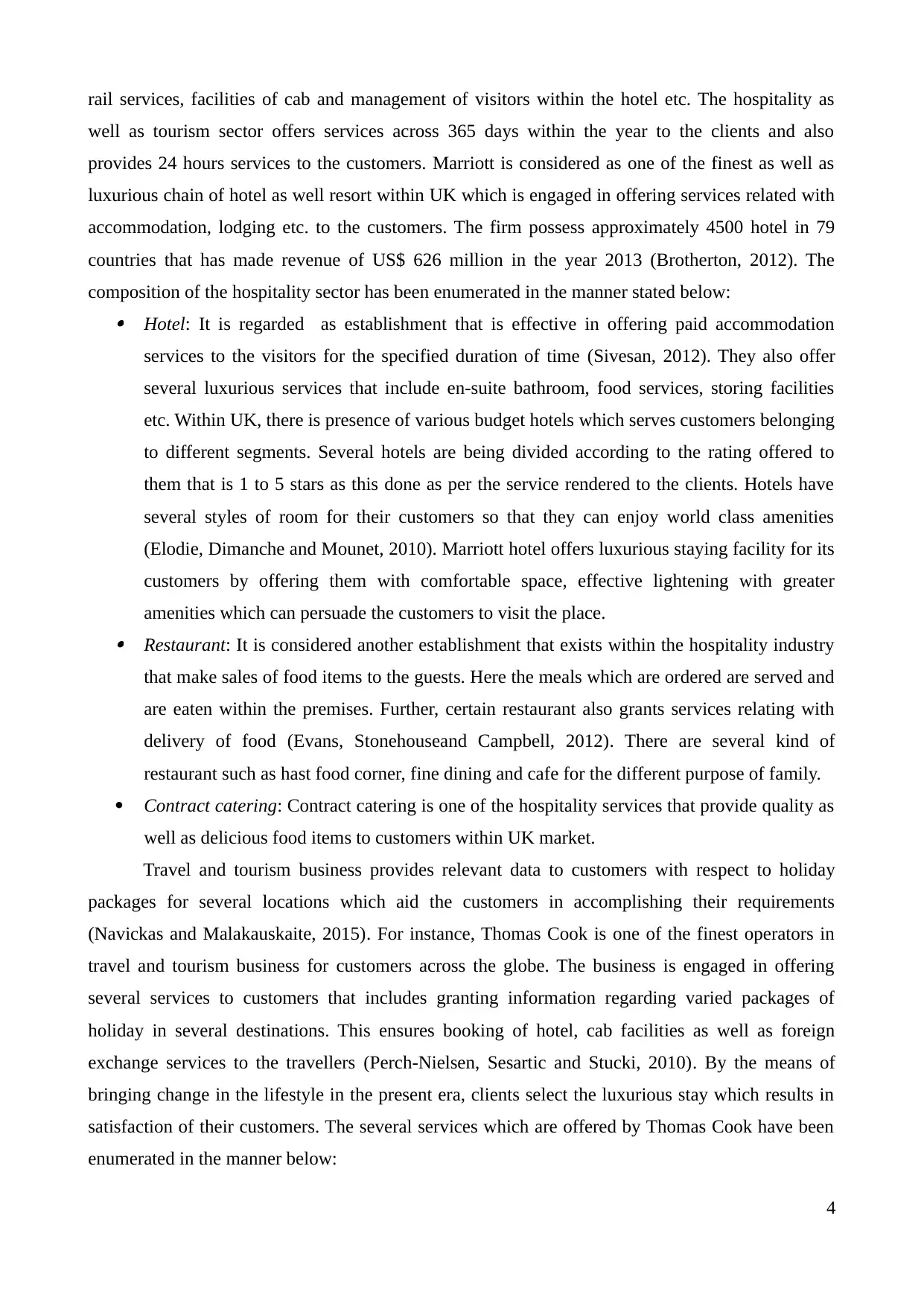
rail services, facilities of cab and management of visitors within the hotel etc. The hospitality as
well as tourism sector offers services across 365 days within the year to the clients and also
provides 24 hours services to the customers. Marriott is considered as one of the finest as well as
luxurious chain of hotel as well resort within UK which is engaged in offering services related with
accommodation, lodging etc. to the customers. The firm possess approximately 4500 hotel in 79
countries that has made revenue of US$ 626 million in the year 2013 (Brotherton, 2012). The
composition of the hospitality sector has been enumerated in the manner stated below: Hotel: It is regarded as establishment that is effective in offering paid accommodation
services to the visitors for the specified duration of time (Sivesan, 2012). They also offer
several luxurious services that include en-suite bathroom, food services, storing facilities
etc. Within UK, there is presence of various budget hotels which serves customers belonging
to different segments. Several hotels are being divided according to the rating offered to
them that is 1 to 5 stars as this done as per the service rendered to the clients. Hotels have
several styles of room for their customers so that they can enjoy world class amenities
(Elodie, Dimanche and Mounet, 2010). Marriott hotel offers luxurious staying facility for its
customers by offering them with comfortable space, effective lightening with greater
amenities which can persuade the customers to visit the place. Restaurant: It is considered another establishment that exists within the hospitality industry
that make sales of food items to the guests. Here the meals which are ordered are served and
are eaten within the premises. Further, certain restaurant also grants services relating with
delivery of food (Evans, Stonehouseand Campbell, 2012). There are several kind of
restaurant such as hast food corner, fine dining and cafe for the different purpose of family.
Contract catering: Contract catering is one of the hospitality services that provide quality as
well as delicious food items to customers within UK market.
Travel and tourism business provides relevant data to customers with respect to holiday
packages for several locations which aid the customers in accomplishing their requirements
(Navickas and Malakauskaite, 2015). For instance, Thomas Cook is one of the finest operators in
travel and tourism business for customers across the globe. The business is engaged in offering
several services to customers that includes granting information regarding varied packages of
holiday in several destinations. This ensures booking of hotel, cab facilities as well as foreign
exchange services to the travellers (Perch-Nielsen, Sesartic and Stucki, 2010). By the means of
bringing change in the lifestyle in the present era, clients select the luxurious stay which results in
satisfaction of their customers. The several services which are offered by Thomas Cook have been
enumerated in the manner below:
4
well as tourism sector offers services across 365 days within the year to the clients and also
provides 24 hours services to the customers. Marriott is considered as one of the finest as well as
luxurious chain of hotel as well resort within UK which is engaged in offering services related with
accommodation, lodging etc. to the customers. The firm possess approximately 4500 hotel in 79
countries that has made revenue of US$ 626 million in the year 2013 (Brotherton, 2012). The
composition of the hospitality sector has been enumerated in the manner stated below: Hotel: It is regarded as establishment that is effective in offering paid accommodation
services to the visitors for the specified duration of time (Sivesan, 2012). They also offer
several luxurious services that include en-suite bathroom, food services, storing facilities
etc. Within UK, there is presence of various budget hotels which serves customers belonging
to different segments. Several hotels are being divided according to the rating offered to
them that is 1 to 5 stars as this done as per the service rendered to the clients. Hotels have
several styles of room for their customers so that they can enjoy world class amenities
(Elodie, Dimanche and Mounet, 2010). Marriott hotel offers luxurious staying facility for its
customers by offering them with comfortable space, effective lightening with greater
amenities which can persuade the customers to visit the place. Restaurant: It is considered another establishment that exists within the hospitality industry
that make sales of food items to the guests. Here the meals which are ordered are served and
are eaten within the premises. Further, certain restaurant also grants services relating with
delivery of food (Evans, Stonehouseand Campbell, 2012). There are several kind of
restaurant such as hast food corner, fine dining and cafe for the different purpose of family.
Contract catering: Contract catering is one of the hospitality services that provide quality as
well as delicious food items to customers within UK market.
Travel and tourism business provides relevant data to customers with respect to holiday
packages for several locations which aid the customers in accomplishing their requirements
(Navickas and Malakauskaite, 2015). For instance, Thomas Cook is one of the finest operators in
travel and tourism business for customers across the globe. The business is engaged in offering
several services to customers that includes granting information regarding varied packages of
holiday in several destinations. This ensures booking of hotel, cab facilities as well as foreign
exchange services to the travellers (Perch-Nielsen, Sesartic and Stucki, 2010). By the means of
bringing change in the lifestyle in the present era, clients select the luxurious stay which results in
satisfaction of their customers. The several services which are offered by Thomas Cook have been
enumerated in the manner below:
4
Secure Best Marks with AI Grader
Need help grading? Try our AI Grader for instant feedback on your assignments.
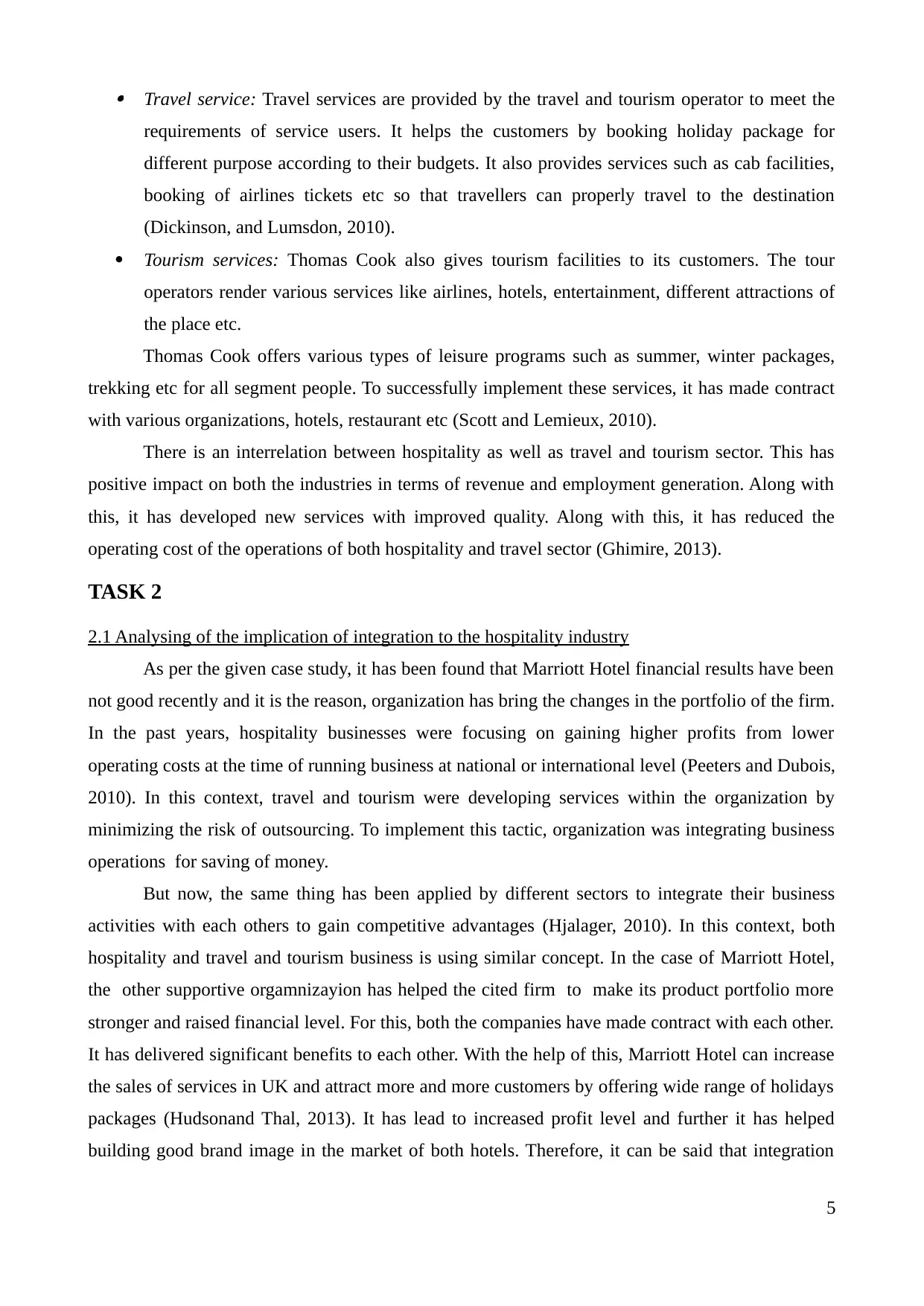
Travel service: Travel services are provided by the travel and tourism operator to meet the
requirements of service users. It helps the customers by booking holiday package for
different purpose according to their budgets. It also provides services such as cab facilities,
booking of airlines tickets etc so that travellers can properly travel to the destination
(Dickinson, and Lumsdon, 2010).
Tourism services: Thomas Cook also gives tourism facilities to its customers. The tour
operators render various services like airlines, hotels, entertainment, different attractions of
the place etc.
Thomas Cook offers various types of leisure programs such as summer, winter packages,
trekking etc for all segment people. To successfully implement these services, it has made contract
with various organizations, hotels, restaurant etc (Scott and Lemieux, 2010).
There is an interrelation between hospitality as well as travel and tourism sector. This has
positive impact on both the industries in terms of revenue and employment generation. Along with
this, it has developed new services with improved quality. Along with this, it has reduced the
operating cost of the operations of both hospitality and travel sector (Ghimire, 2013).
TASK 2
2.1 Analysing of the implication of integration to the hospitality industry
As per the given case study, it has been found that Marriott Hotel financial results have been
not good recently and it is the reason, organization has bring the changes in the portfolio of the firm.
In the past years, hospitality businesses were focusing on gaining higher profits from lower
operating costs at the time of running business at national or international level (Peeters and Dubois,
2010). In this context, travel and tourism were developing services within the organization by
minimizing the risk of outsourcing. To implement this tactic, organization was integrating business
operations for saving of money.
But now, the same thing has been applied by different sectors to integrate their business
activities with each others to gain competitive advantages (Hjalager, 2010). In this context, both
hospitality and travel and tourism business is using similar concept. In the case of Marriott Hotel,
the other supportive orgamnizayion has helped the cited firm to make its product portfolio more
stronger and raised financial level. For this, both the companies have made contract with each other.
It has delivered significant benefits to each other. With the help of this, Marriott Hotel can increase
the sales of services in UK and attract more and more customers by offering wide range of holidays
packages (Hudsonand Thal, 2013). It has lead to increased profit level and further it has helped
building good brand image in the market of both hotels. Therefore, it can be said that integration
5
requirements of service users. It helps the customers by booking holiday package for
different purpose according to their budgets. It also provides services such as cab facilities,
booking of airlines tickets etc so that travellers can properly travel to the destination
(Dickinson, and Lumsdon, 2010).
Tourism services: Thomas Cook also gives tourism facilities to its customers. The tour
operators render various services like airlines, hotels, entertainment, different attractions of
the place etc.
Thomas Cook offers various types of leisure programs such as summer, winter packages,
trekking etc for all segment people. To successfully implement these services, it has made contract
with various organizations, hotels, restaurant etc (Scott and Lemieux, 2010).
There is an interrelation between hospitality as well as travel and tourism sector. This has
positive impact on both the industries in terms of revenue and employment generation. Along with
this, it has developed new services with improved quality. Along with this, it has reduced the
operating cost of the operations of both hospitality and travel sector (Ghimire, 2013).
TASK 2
2.1 Analysing of the implication of integration to the hospitality industry
As per the given case study, it has been found that Marriott Hotel financial results have been
not good recently and it is the reason, organization has bring the changes in the portfolio of the firm.
In the past years, hospitality businesses were focusing on gaining higher profits from lower
operating costs at the time of running business at national or international level (Peeters and Dubois,
2010). In this context, travel and tourism were developing services within the organization by
minimizing the risk of outsourcing. To implement this tactic, organization was integrating business
operations for saving of money.
But now, the same thing has been applied by different sectors to integrate their business
activities with each others to gain competitive advantages (Hjalager, 2010). In this context, both
hospitality and travel and tourism business is using similar concept. In the case of Marriott Hotel,
the other supportive orgamnizayion has helped the cited firm to make its product portfolio more
stronger and raised financial level. For this, both the companies have made contract with each other.
It has delivered significant benefits to each other. With the help of this, Marriott Hotel can increase
the sales of services in UK and attract more and more customers by offering wide range of holidays
packages (Hudsonand Thal, 2013). It has lead to increased profit level and further it has helped
building good brand image in the market of both hotels. Therefore, it can be said that integration
5
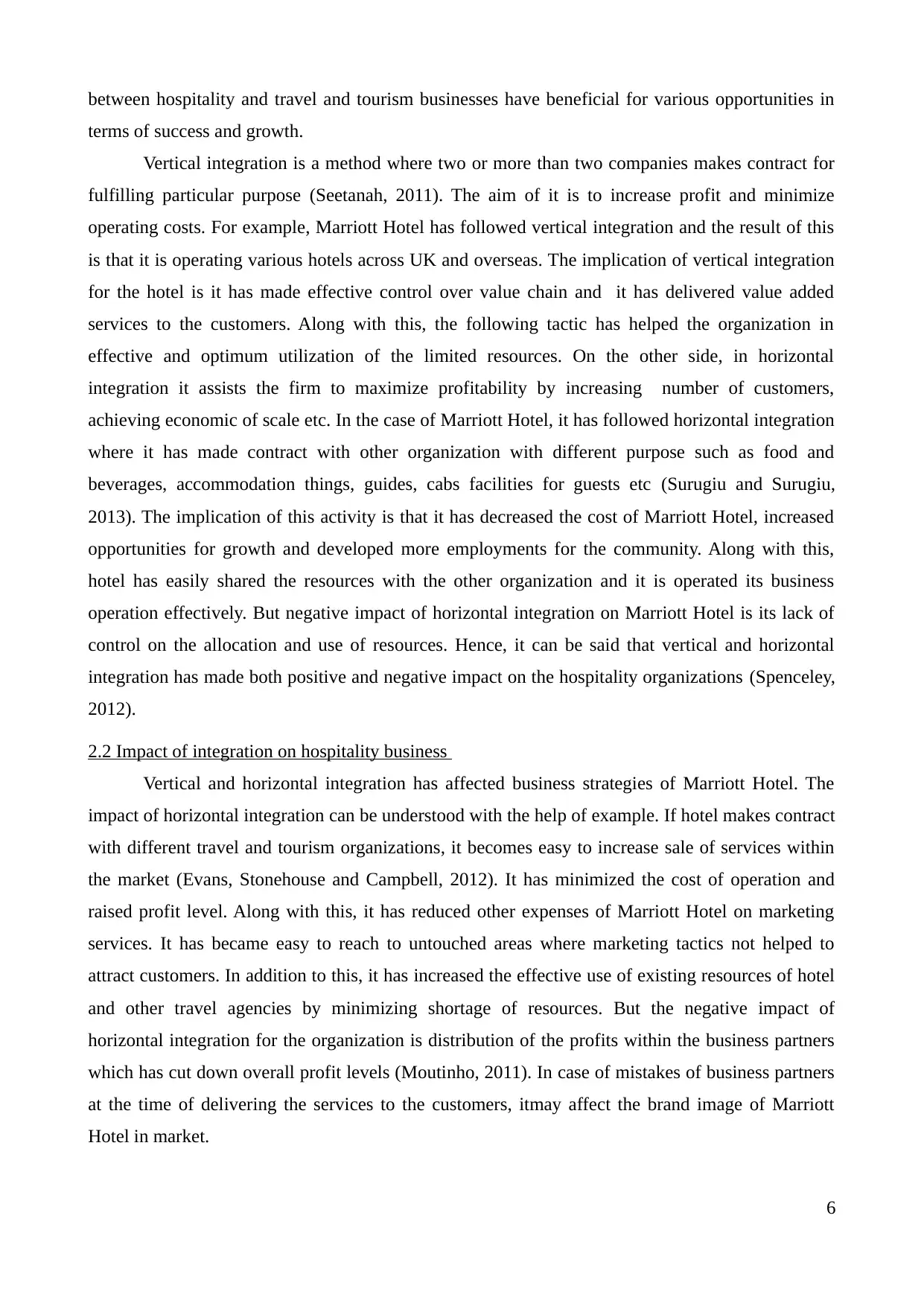
between hospitality and travel and tourism businesses have beneficial for various opportunities in
terms of success and growth.
Vertical integration is a method where two or more than two companies makes contract for
fulfilling particular purpose (Seetanah, 2011). The aim of it is to increase profit and minimize
operating costs. For example, Marriott Hotel has followed vertical integration and the result of this
is that it is operating various hotels across UK and overseas. The implication of vertical integration
for the hotel is it has made effective control over value chain and it has delivered value added
services to the customers. Along with this, the following tactic has helped the organization in
effective and optimum utilization of the limited resources. On the other side, in horizontal
integration it assists the firm to maximize profitability by increasing number of customers,
achieving economic of scale etc. In the case of Marriott Hotel, it has followed horizontal integration
where it has made contract with other organization with different purpose such as food and
beverages, accommodation things, guides, cabs facilities for guests etc (Surugiu and Surugiu,
2013). The implication of this activity is that it has decreased the cost of Marriott Hotel, increased
opportunities for growth and developed more employments for the community. Along with this,
hotel has easily shared the resources with the other organization and it is operated its business
operation effectively. But negative impact of horizontal integration on Marriott Hotel is its lack of
control on the allocation and use of resources. Hence, it can be said that vertical and horizontal
integration has made both positive and negative impact on the hospitality organizations (Spenceley,
2012).
2.2 Impact of integration on hospitality business
Vertical and horizontal integration has affected business strategies of Marriott Hotel. The
impact of horizontal integration can be understood with the help of example. If hotel makes contract
with different travel and tourism organizations, it becomes easy to increase sale of services within
the market (Evans, Stonehouse and Campbell, 2012). It has minimized the cost of operation and
raised profit level. Along with this, it has reduced other expenses of Marriott Hotel on marketing
services. It has became easy to reach to untouched areas where marketing tactics not helped to
attract customers. In addition to this, it has increased the effective use of existing resources of hotel
and other travel agencies by minimizing shortage of resources. But the negative impact of
horizontal integration for the organization is distribution of the profits within the business partners
which has cut down overall profit levels (Moutinho, 2011). In case of mistakes of business partners
at the time of delivering the services to the customers, itmay affect the brand image of Marriott
Hotel in market.
6
terms of success and growth.
Vertical integration is a method where two or more than two companies makes contract for
fulfilling particular purpose (Seetanah, 2011). The aim of it is to increase profit and minimize
operating costs. For example, Marriott Hotel has followed vertical integration and the result of this
is that it is operating various hotels across UK and overseas. The implication of vertical integration
for the hotel is it has made effective control over value chain and it has delivered value added
services to the customers. Along with this, the following tactic has helped the organization in
effective and optimum utilization of the limited resources. On the other side, in horizontal
integration it assists the firm to maximize profitability by increasing number of customers,
achieving economic of scale etc. In the case of Marriott Hotel, it has followed horizontal integration
where it has made contract with other organization with different purpose such as food and
beverages, accommodation things, guides, cabs facilities for guests etc (Surugiu and Surugiu,
2013). The implication of this activity is that it has decreased the cost of Marriott Hotel, increased
opportunities for growth and developed more employments for the community. Along with this,
hotel has easily shared the resources with the other organization and it is operated its business
operation effectively. But negative impact of horizontal integration on Marriott Hotel is its lack of
control on the allocation and use of resources. Hence, it can be said that vertical and horizontal
integration has made both positive and negative impact on the hospitality organizations (Spenceley,
2012).
2.2 Impact of integration on hospitality business
Vertical and horizontal integration has affected business strategies of Marriott Hotel. The
impact of horizontal integration can be understood with the help of example. If hotel makes contract
with different travel and tourism organizations, it becomes easy to increase sale of services within
the market (Evans, Stonehouse and Campbell, 2012). It has minimized the cost of operation and
raised profit level. Along with this, it has reduced other expenses of Marriott Hotel on marketing
services. It has became easy to reach to untouched areas where marketing tactics not helped to
attract customers. In addition to this, it has increased the effective use of existing resources of hotel
and other travel agencies by minimizing shortage of resources. But the negative impact of
horizontal integration for the organization is distribution of the profits within the business partners
which has cut down overall profit levels (Moutinho, 2011). In case of mistakes of business partners
at the time of delivering the services to the customers, itmay affect the brand image of Marriott
Hotel in market.
6
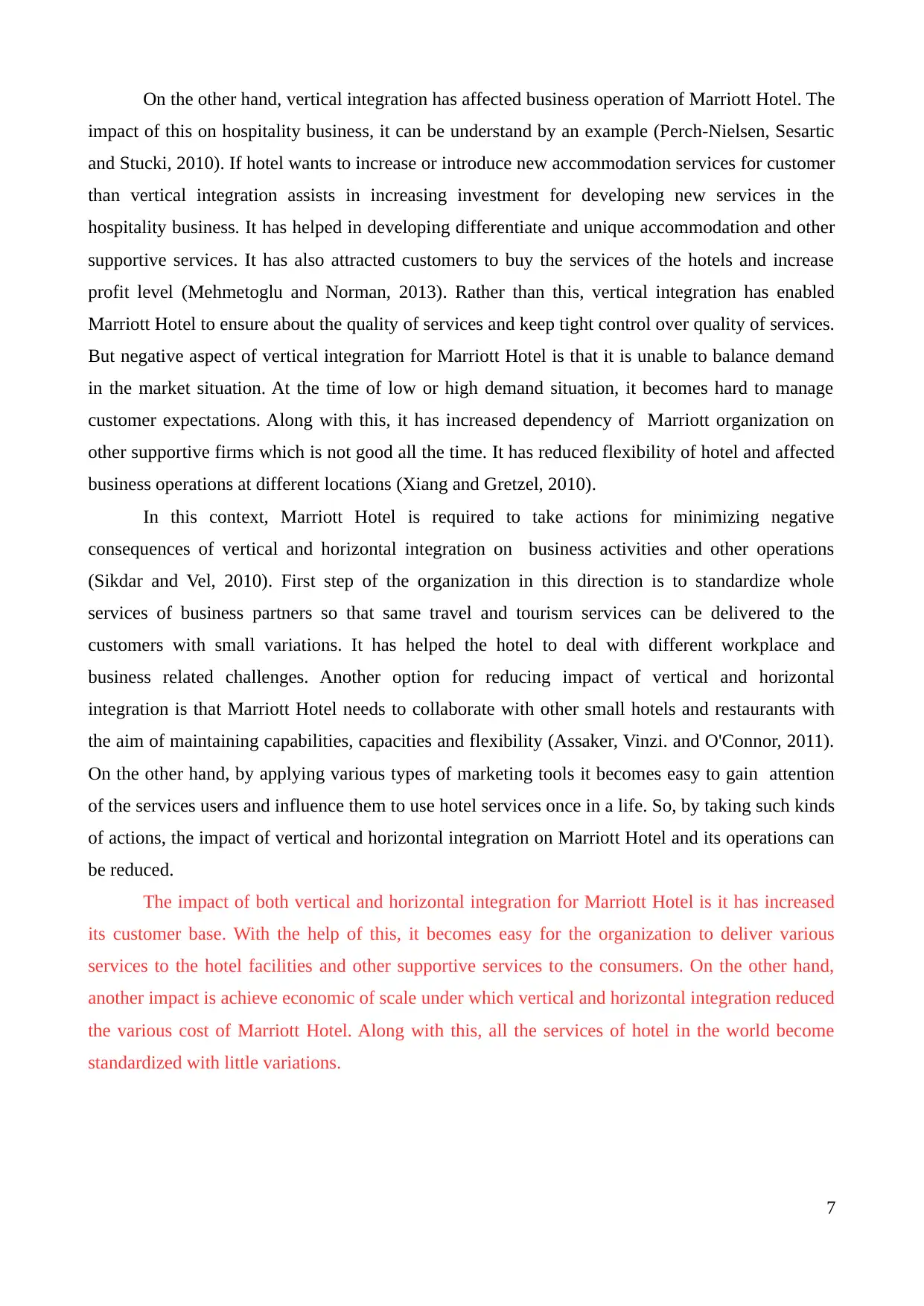
On the other hand, vertical integration has affected business operation of Marriott Hotel. The
impact of this on hospitality business, it can be understand by an example (Perch-Nielsen, Sesartic
and Stucki, 2010). If hotel wants to increase or introduce new accommodation services for customer
than vertical integration assists in increasing investment for developing new services in the
hospitality business. It has helped in developing differentiate and unique accommodation and other
supportive services. It has also attracted customers to buy the services of the hotels and increase
profit level (Mehmetoglu and Norman, 2013). Rather than this, vertical integration has enabled
Marriott Hotel to ensure about the quality of services and keep tight control over quality of services.
But negative aspect of vertical integration for Marriott Hotel is that it is unable to balance demand
in the market situation. At the time of low or high demand situation, it becomes hard to manage
customer expectations. Along with this, it has increased dependency of Marriott organization on
other supportive firms which is not good all the time. It has reduced flexibility of hotel and affected
business operations at different locations (Xiang and Gretzel, 2010).
In this context, Marriott Hotel is required to take actions for minimizing negative
consequences of vertical and horizontal integration on business activities and other operations
(Sikdar and Vel, 2010). First step of the organization in this direction is to standardize whole
services of business partners so that same travel and tourism services can be delivered to the
customers with small variations. It has helped the hotel to deal with different workplace and
business related challenges. Another option for reducing impact of vertical and horizontal
integration is that Marriott Hotel needs to collaborate with other small hotels and restaurants with
the aim of maintaining capabilities, capacities and flexibility (Assaker, Vinzi. and O'Connor, 2011).
On the other hand, by applying various types of marketing tools it becomes easy to gain attention
of the services users and influence them to use hotel services once in a life. So, by taking such kinds
of actions, the impact of vertical and horizontal integration on Marriott Hotel and its operations can
be reduced.
The impact of both vertical and horizontal integration for Marriott Hotel is it has increased
its customer base. With the help of this, it becomes easy for the organization to deliver various
services to the hotel facilities and other supportive services to the consumers. On the other hand,
another impact is achieve economic of scale under which vertical and horizontal integration reduced
the various cost of Marriott Hotel. Along with this, all the services of hotel in the world become
standardized with little variations.
7
impact of this on hospitality business, it can be understand by an example (Perch-Nielsen, Sesartic
and Stucki, 2010). If hotel wants to increase or introduce new accommodation services for customer
than vertical integration assists in increasing investment for developing new services in the
hospitality business. It has helped in developing differentiate and unique accommodation and other
supportive services. It has also attracted customers to buy the services of the hotels and increase
profit level (Mehmetoglu and Norman, 2013). Rather than this, vertical integration has enabled
Marriott Hotel to ensure about the quality of services and keep tight control over quality of services.
But negative aspect of vertical integration for Marriott Hotel is that it is unable to balance demand
in the market situation. At the time of low or high demand situation, it becomes hard to manage
customer expectations. Along with this, it has increased dependency of Marriott organization on
other supportive firms which is not good all the time. It has reduced flexibility of hotel and affected
business operations at different locations (Xiang and Gretzel, 2010).
In this context, Marriott Hotel is required to take actions for minimizing negative
consequences of vertical and horizontal integration on business activities and other operations
(Sikdar and Vel, 2010). First step of the organization in this direction is to standardize whole
services of business partners so that same travel and tourism services can be delivered to the
customers with small variations. It has helped the hotel to deal with different workplace and
business related challenges. Another option for reducing impact of vertical and horizontal
integration is that Marriott Hotel needs to collaborate with other small hotels and restaurants with
the aim of maintaining capabilities, capacities and flexibility (Assaker, Vinzi. and O'Connor, 2011).
On the other hand, by applying various types of marketing tools it becomes easy to gain attention
of the services users and influence them to use hotel services once in a life. So, by taking such kinds
of actions, the impact of vertical and horizontal integration on Marriott Hotel and its operations can
be reduced.
The impact of both vertical and horizontal integration for Marriott Hotel is it has increased
its customer base. With the help of this, it becomes easy for the organization to deliver various
services to the hotel facilities and other supportive services to the consumers. On the other hand,
another impact is achieve economic of scale under which vertical and horizontal integration reduced
the various cost of Marriott Hotel. Along with this, all the services of hotel in the world become
standardized with little variations.
7
Paraphrase This Document
Need a fresh take? Get an instant paraphrase of this document with our AI Paraphraser
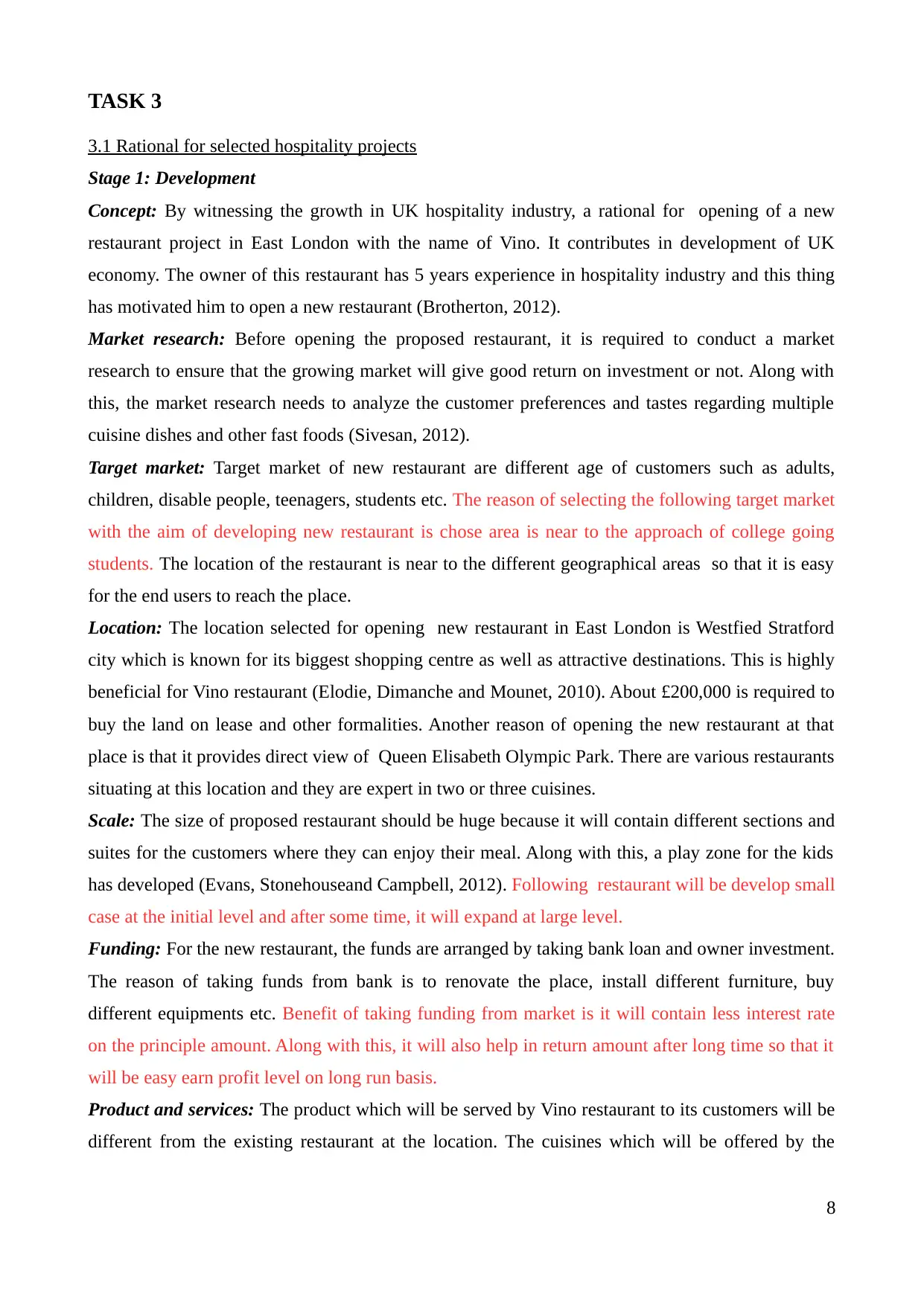
TASK 3
3.1 Rational for selected hospitality projects
Stage 1: Development
Concept: By witnessing the growth in UK hospitality industry, a rational for opening of a new
restaurant project in East London with the name of Vino. It contributes in development of UK
economy. The owner of this restaurant has 5 years experience in hospitality industry and this thing
has motivated him to open a new restaurant (Brotherton, 2012).
Market research: Before opening the proposed restaurant, it is required to conduct a market
research to ensure that the growing market will give good return on investment or not. Along with
this, the market research needs to analyze the customer preferences and tastes regarding multiple
cuisine dishes and other fast foods (Sivesan, 2012).
Target market: Target market of new restaurant are different age of customers such as adults,
children, disable people, teenagers, students etc. The reason of selecting the following target market
with the aim of developing new restaurant is chose area is near to the approach of college going
students. The location of the restaurant is near to the different geographical areas so that it is easy
for the end users to reach the place.
Location: The location selected for opening new restaurant in East London is Westfied Stratford
city which is known for its biggest shopping centre as well as attractive destinations. This is highly
beneficial for Vino restaurant (Elodie, Dimanche and Mounet, 2010). About £200,000 is required to
buy the land on lease and other formalities. Another reason of opening the new restaurant at that
place is that it provides direct view of Queen Elisabeth Olympic Park. There are various restaurants
situating at this location and they are expert in two or three cuisines.
Scale: The size of proposed restaurant should be huge because it will contain different sections and
suites for the customers where they can enjoy their meal. Along with this, a play zone for the kids
has developed (Evans, Stonehouseand Campbell, 2012). Following restaurant will be develop small
case at the initial level and after some time, it will expand at large level.
Funding: For the new restaurant, the funds are arranged by taking bank loan and owner investment.
The reason of taking funds from bank is to renovate the place, install different furniture, buy
different equipments etc. Benefit of taking funding from market is it will contain less interest rate
on the principle amount. Along with this, it will also help in return amount after long time so that it
will be easy earn profit level on long run basis.
Product and services: The product which will be served by Vino restaurant to its customers will be
different from the existing restaurant at the location. The cuisines which will be offered by the
8
3.1 Rational for selected hospitality projects
Stage 1: Development
Concept: By witnessing the growth in UK hospitality industry, a rational for opening of a new
restaurant project in East London with the name of Vino. It contributes in development of UK
economy. The owner of this restaurant has 5 years experience in hospitality industry and this thing
has motivated him to open a new restaurant (Brotherton, 2012).
Market research: Before opening the proposed restaurant, it is required to conduct a market
research to ensure that the growing market will give good return on investment or not. Along with
this, the market research needs to analyze the customer preferences and tastes regarding multiple
cuisine dishes and other fast foods (Sivesan, 2012).
Target market: Target market of new restaurant are different age of customers such as adults,
children, disable people, teenagers, students etc. The reason of selecting the following target market
with the aim of developing new restaurant is chose area is near to the approach of college going
students. The location of the restaurant is near to the different geographical areas so that it is easy
for the end users to reach the place.
Location: The location selected for opening new restaurant in East London is Westfied Stratford
city which is known for its biggest shopping centre as well as attractive destinations. This is highly
beneficial for Vino restaurant (Elodie, Dimanche and Mounet, 2010). About £200,000 is required to
buy the land on lease and other formalities. Another reason of opening the new restaurant at that
place is that it provides direct view of Queen Elisabeth Olympic Park. There are various restaurants
situating at this location and they are expert in two or three cuisines.
Scale: The size of proposed restaurant should be huge because it will contain different sections and
suites for the customers where they can enjoy their meal. Along with this, a play zone for the kids
has developed (Evans, Stonehouseand Campbell, 2012). Following restaurant will be develop small
case at the initial level and after some time, it will expand at large level.
Funding: For the new restaurant, the funds are arranged by taking bank loan and owner investment.
The reason of taking funds from bank is to renovate the place, install different furniture, buy
different equipments etc. Benefit of taking funding from market is it will contain less interest rate
on the principle amount. Along with this, it will also help in return amount after long time so that it
will be easy earn profit level on long run basis.
Product and services: The product which will be served by Vino restaurant to its customers will be
different from the existing restaurant at the location. The cuisines which will be offered by the
8
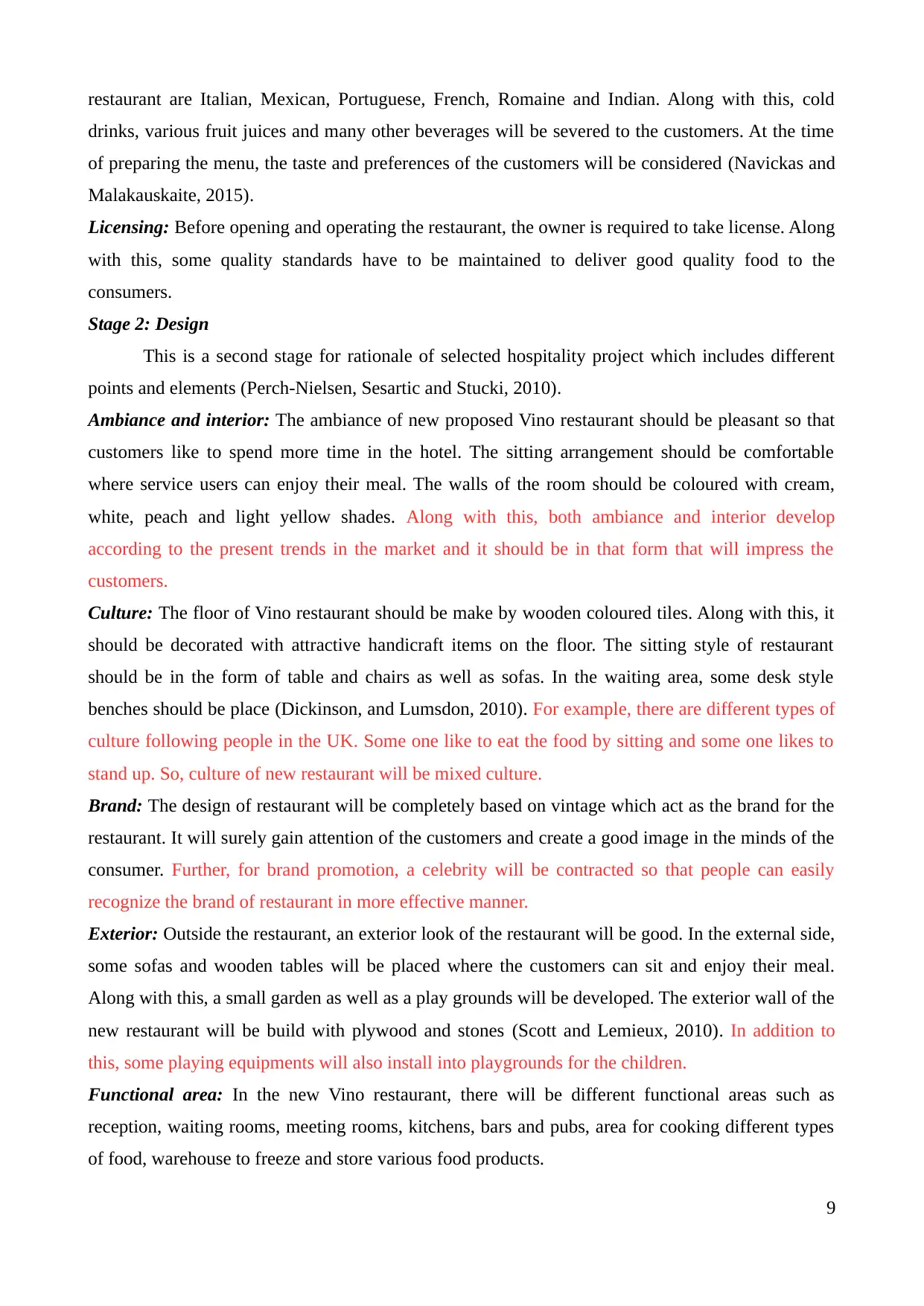
restaurant are Italian, Mexican, Portuguese, French, Romaine and Indian. Along with this, cold
drinks, various fruit juices and many other beverages will be severed to the customers. At the time
of preparing the menu, the taste and preferences of the customers will be considered (Navickas and
Malakauskaite, 2015).
Licensing: Before opening and operating the restaurant, the owner is required to take license. Along
with this, some quality standards have to be maintained to deliver good quality food to the
consumers.
Stage 2: Design
This is a second stage for rationale of selected hospitality project which includes different
points and elements (Perch-Nielsen, Sesartic and Stucki, 2010).
Ambiance and interior: The ambiance of new proposed Vino restaurant should be pleasant so that
customers like to spend more time in the hotel. The sitting arrangement should be comfortable
where service users can enjoy their meal. The walls of the room should be coloured with cream,
white, peach and light yellow shades. Along with this, both ambiance and interior develop
according to the present trends in the market and it should be in that form that will impress the
customers.
Culture: The floor of Vino restaurant should be make by wooden coloured tiles. Along with this, it
should be decorated with attractive handicraft items on the floor. The sitting style of restaurant
should be in the form of table and chairs as well as sofas. In the waiting area, some desk style
benches should be place (Dickinson, and Lumsdon, 2010). For example, there are different types of
culture following people in the UK. Some one like to eat the food by sitting and some one likes to
stand up. So, culture of new restaurant will be mixed culture.
Brand: The design of restaurant will be completely based on vintage which act as the brand for the
restaurant. It will surely gain attention of the customers and create a good image in the minds of the
consumer. Further, for brand promotion, a celebrity will be contracted so that people can easily
recognize the brand of restaurant in more effective manner.
Exterior: Outside the restaurant, an exterior look of the restaurant will be good. In the external side,
some sofas and wooden tables will be placed where the customers can sit and enjoy their meal.
Along with this, a small garden as well as a play grounds will be developed. The exterior wall of the
new restaurant will be build with plywood and stones (Scott and Lemieux, 2010). In addition to
this, some playing equipments will also install into playgrounds for the children.
Functional area: In the new Vino restaurant, there will be different functional areas such as
reception, waiting rooms, meeting rooms, kitchens, bars and pubs, area for cooking different types
of food, warehouse to freeze and store various food products.
9
drinks, various fruit juices and many other beverages will be severed to the customers. At the time
of preparing the menu, the taste and preferences of the customers will be considered (Navickas and
Malakauskaite, 2015).
Licensing: Before opening and operating the restaurant, the owner is required to take license. Along
with this, some quality standards have to be maintained to deliver good quality food to the
consumers.
Stage 2: Design
This is a second stage for rationale of selected hospitality project which includes different
points and elements (Perch-Nielsen, Sesartic and Stucki, 2010).
Ambiance and interior: The ambiance of new proposed Vino restaurant should be pleasant so that
customers like to spend more time in the hotel. The sitting arrangement should be comfortable
where service users can enjoy their meal. The walls of the room should be coloured with cream,
white, peach and light yellow shades. Along with this, both ambiance and interior develop
according to the present trends in the market and it should be in that form that will impress the
customers.
Culture: The floor of Vino restaurant should be make by wooden coloured tiles. Along with this, it
should be decorated with attractive handicraft items on the floor. The sitting style of restaurant
should be in the form of table and chairs as well as sofas. In the waiting area, some desk style
benches should be place (Dickinson, and Lumsdon, 2010). For example, there are different types of
culture following people in the UK. Some one like to eat the food by sitting and some one likes to
stand up. So, culture of new restaurant will be mixed culture.
Brand: The design of restaurant will be completely based on vintage which act as the brand for the
restaurant. It will surely gain attention of the customers and create a good image in the minds of the
consumer. Further, for brand promotion, a celebrity will be contracted so that people can easily
recognize the brand of restaurant in more effective manner.
Exterior: Outside the restaurant, an exterior look of the restaurant will be good. In the external side,
some sofas and wooden tables will be placed where the customers can sit and enjoy their meal.
Along with this, a small garden as well as a play grounds will be developed. The exterior wall of the
new restaurant will be build with plywood and stones (Scott and Lemieux, 2010). In addition to
this, some playing equipments will also install into playgrounds for the children.
Functional area: In the new Vino restaurant, there will be different functional areas such as
reception, waiting rooms, meeting rooms, kitchens, bars and pubs, area for cooking different types
of food, warehouse to freeze and store various food products.
9
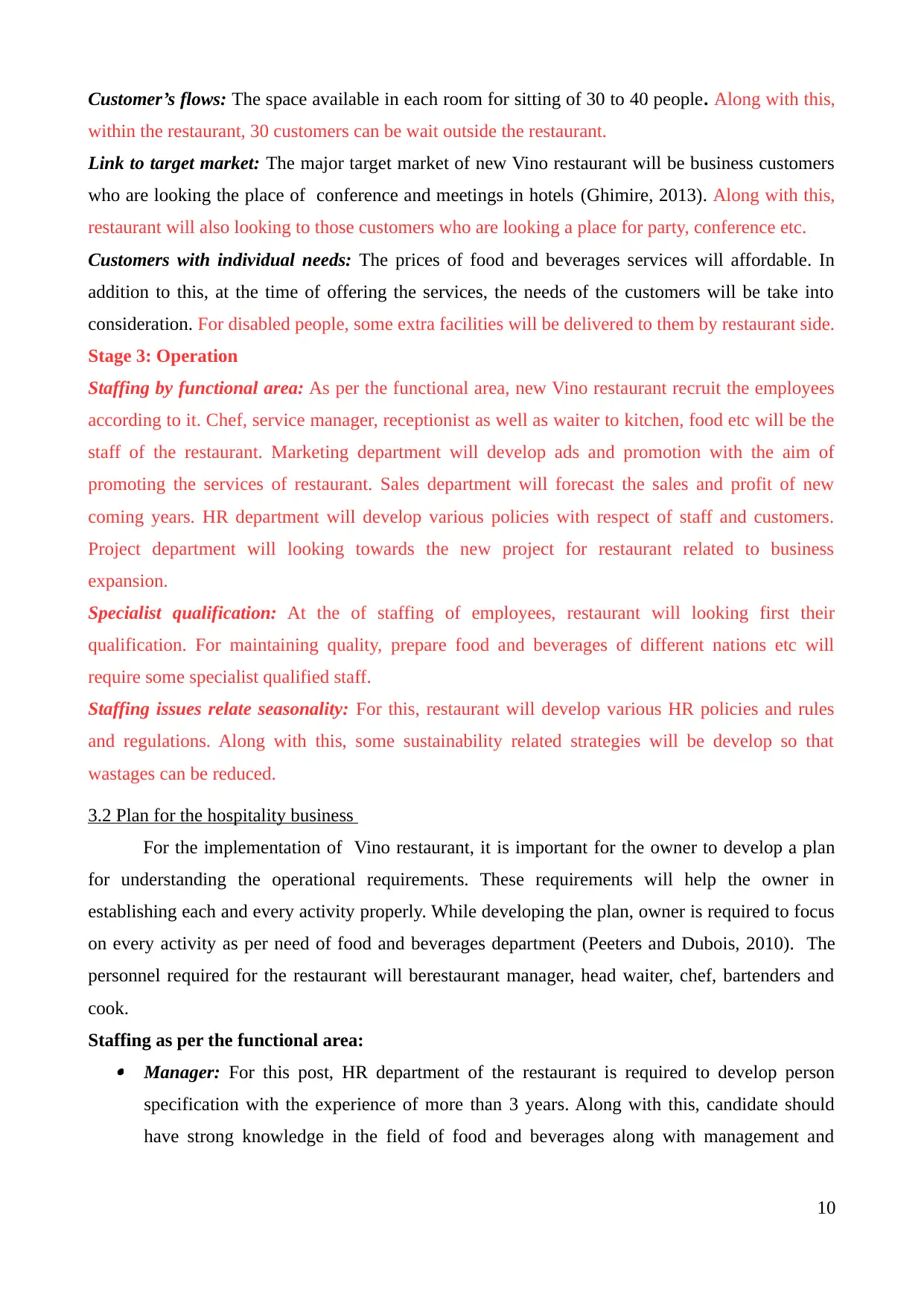
Customer’s flows: The space available in each room for sitting of 30 to 40 people. Along with this,
within the restaurant, 30 customers can be wait outside the restaurant.
Link to target market: The major target market of new Vino restaurant will be business customers
who are looking the place of conference and meetings in hotels (Ghimire, 2013). Along with this,
restaurant will also looking to those customers who are looking a place for party, conference etc.
Customers with individual needs: The prices of food and beverages services will affordable. In
addition to this, at the time of offering the services, the needs of the customers will be take into
consideration. For disabled people, some extra facilities will be delivered to them by restaurant side.
Stage 3: Operation
Staffing by functional area: As per the functional area, new Vino restaurant recruit the employees
according to it. Chef, service manager, receptionist as well as waiter to kitchen, food etc will be the
staff of the restaurant. Marketing department will develop ads and promotion with the aim of
promoting the services of restaurant. Sales department will forecast the sales and profit of new
coming years. HR department will develop various policies with respect of staff and customers.
Project department will looking towards the new project for restaurant related to business
expansion.
Specialist qualification: At the of staffing of employees, restaurant will looking first their
qualification. For maintaining quality, prepare food and beverages of different nations etc will
require some specialist qualified staff.
Staffing issues relate seasonality: For this, restaurant will develop various HR policies and rules
and regulations. Along with this, some sustainability related strategies will be develop so that
wastages can be reduced.
3.2 Plan for the hospitality business
For the implementation of Vino restaurant, it is important for the owner to develop a plan
for understanding the operational requirements. These requirements will help the owner in
establishing each and every activity properly. While developing the plan, owner is required to focus
on every activity as per need of food and beverages department (Peeters and Dubois, 2010). The
personnel required for the restaurant will berestaurant manager, head waiter, chef, bartenders and
cook.
Staffing as per the functional area: Manager: For this post, HR department of the restaurant is required to develop person
specification with the experience of more than 3 years. Along with this, candidate should
have strong knowledge in the field of food and beverages along with management and
10
within the restaurant, 30 customers can be wait outside the restaurant.
Link to target market: The major target market of new Vino restaurant will be business customers
who are looking the place of conference and meetings in hotels (Ghimire, 2013). Along with this,
restaurant will also looking to those customers who are looking a place for party, conference etc.
Customers with individual needs: The prices of food and beverages services will affordable. In
addition to this, at the time of offering the services, the needs of the customers will be take into
consideration. For disabled people, some extra facilities will be delivered to them by restaurant side.
Stage 3: Operation
Staffing by functional area: As per the functional area, new Vino restaurant recruit the employees
according to it. Chef, service manager, receptionist as well as waiter to kitchen, food etc will be the
staff of the restaurant. Marketing department will develop ads and promotion with the aim of
promoting the services of restaurant. Sales department will forecast the sales and profit of new
coming years. HR department will develop various policies with respect of staff and customers.
Project department will looking towards the new project for restaurant related to business
expansion.
Specialist qualification: At the of staffing of employees, restaurant will looking first their
qualification. For maintaining quality, prepare food and beverages of different nations etc will
require some specialist qualified staff.
Staffing issues relate seasonality: For this, restaurant will develop various HR policies and rules
and regulations. Along with this, some sustainability related strategies will be develop so that
wastages can be reduced.
3.2 Plan for the hospitality business
For the implementation of Vino restaurant, it is important for the owner to develop a plan
for understanding the operational requirements. These requirements will help the owner in
establishing each and every activity properly. While developing the plan, owner is required to focus
on every activity as per need of food and beverages department (Peeters and Dubois, 2010). The
personnel required for the restaurant will berestaurant manager, head waiter, chef, bartenders and
cook.
Staffing as per the functional area: Manager: For this post, HR department of the restaurant is required to develop person
specification with the experience of more than 3 years. Along with this, candidate should
have strong knowledge in the field of food and beverages along with management and
10
Secure Best Marks with AI Grader
Need help grading? Try our AI Grader for instant feedback on your assignments.
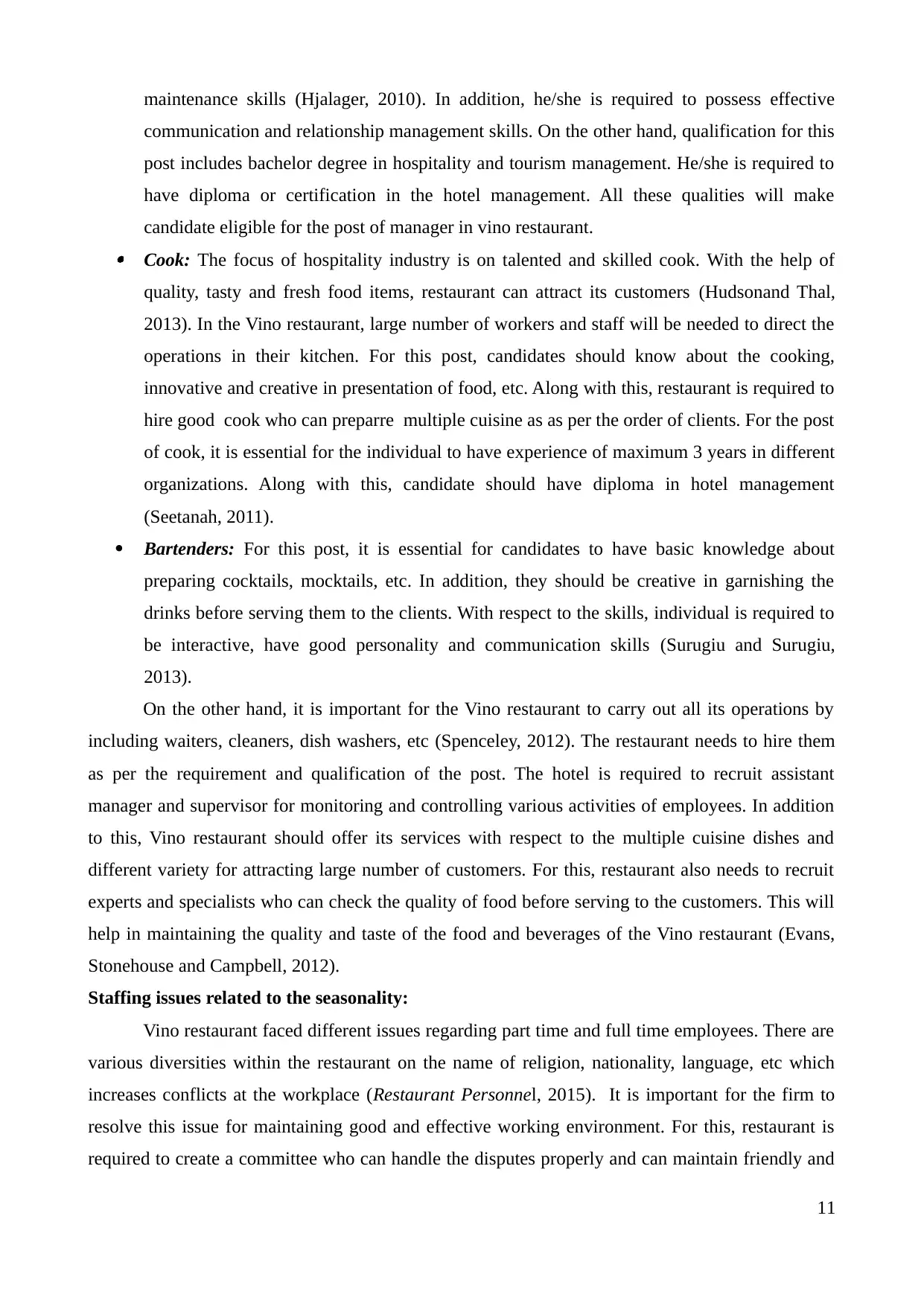
maintenance skills (Hjalager, 2010). In addition, he/she is required to possess effective
communication and relationship management skills. On the other hand, qualification for this
post includes bachelor degree in hospitality and tourism management. He/she is required to
have diploma or certification in the hotel management. All these qualities will make
candidate eligible for the post of manager in vino restaurant. Cook: The focus of hospitality industry is on talented and skilled cook. With the help of
quality, tasty and fresh food items, restaurant can attract its customers (Hudsonand Thal,
2013). In the Vino restaurant, large number of workers and staff will be needed to direct the
operations in their kitchen. For this post, candidates should know about the cooking,
innovative and creative in presentation of food, etc. Along with this, restaurant is required to
hire good cook who can preparre multiple cuisine as as per the order of clients. For the post
of cook, it is essential for the individual to have experience of maximum 3 years in different
organizations. Along with this, candidate should have diploma in hotel management
(Seetanah, 2011).
Bartenders: For this post, it is essential for candidates to have basic knowledge about
preparing cocktails, mocktails, etc. In addition, they should be creative in garnishing the
drinks before serving them to the clients. With respect to the skills, individual is required to
be interactive, have good personality and communication skills (Surugiu and Surugiu,
2013).
On the other hand, it is important for the Vino restaurant to carry out all its operations by
including waiters, cleaners, dish washers, etc (Spenceley, 2012). The restaurant needs to hire them
as per the requirement and qualification of the post. The hotel is required to recruit assistant
manager and supervisor for monitoring and controlling various activities of employees. In addition
to this, Vino restaurant should offer its services with respect to the multiple cuisine dishes and
different variety for attracting large number of customers. For this, restaurant also needs to recruit
experts and specialists who can check the quality of food before serving to the customers. This will
help in maintaining the quality and taste of the food and beverages of the Vino restaurant (Evans,
Stonehouse and Campbell, 2012).
Staffing issues related to the seasonality:
Vino restaurant faced different issues regarding part time and full time employees. There are
various diversities within the restaurant on the name of religion, nationality, language, etc which
increases conflicts at the workplace (Restaurant Personnel, 2015). It is important for the firm to
resolve this issue for maintaining good and effective working environment. For this, restaurant is
required to create a committee who can handle the disputes properly and can maintain friendly and
11
communication and relationship management skills. On the other hand, qualification for this
post includes bachelor degree in hospitality and tourism management. He/she is required to
have diploma or certification in the hotel management. All these qualities will make
candidate eligible for the post of manager in vino restaurant. Cook: The focus of hospitality industry is on talented and skilled cook. With the help of
quality, tasty and fresh food items, restaurant can attract its customers (Hudsonand Thal,
2013). In the Vino restaurant, large number of workers and staff will be needed to direct the
operations in their kitchen. For this post, candidates should know about the cooking,
innovative and creative in presentation of food, etc. Along with this, restaurant is required to
hire good cook who can preparre multiple cuisine as as per the order of clients. For the post
of cook, it is essential for the individual to have experience of maximum 3 years in different
organizations. Along with this, candidate should have diploma in hotel management
(Seetanah, 2011).
Bartenders: For this post, it is essential for candidates to have basic knowledge about
preparing cocktails, mocktails, etc. In addition, they should be creative in garnishing the
drinks before serving them to the clients. With respect to the skills, individual is required to
be interactive, have good personality and communication skills (Surugiu and Surugiu,
2013).
On the other hand, it is important for the Vino restaurant to carry out all its operations by
including waiters, cleaners, dish washers, etc (Spenceley, 2012). The restaurant needs to hire them
as per the requirement and qualification of the post. The hotel is required to recruit assistant
manager and supervisor for monitoring and controlling various activities of employees. In addition
to this, Vino restaurant should offer its services with respect to the multiple cuisine dishes and
different variety for attracting large number of customers. For this, restaurant also needs to recruit
experts and specialists who can check the quality of food before serving to the customers. This will
help in maintaining the quality and taste of the food and beverages of the Vino restaurant (Evans,
Stonehouse and Campbell, 2012).
Staffing issues related to the seasonality:
Vino restaurant faced different issues regarding part time and full time employees. There are
various diversities within the restaurant on the name of religion, nationality, language, etc which
increases conflicts at the workplace (Restaurant Personnel, 2015). It is important for the firm to
resolve this issue for maintaining good and effective working environment. For this, restaurant is
required to create a committee who can handle the disputes properly and can maintain friendly and
11
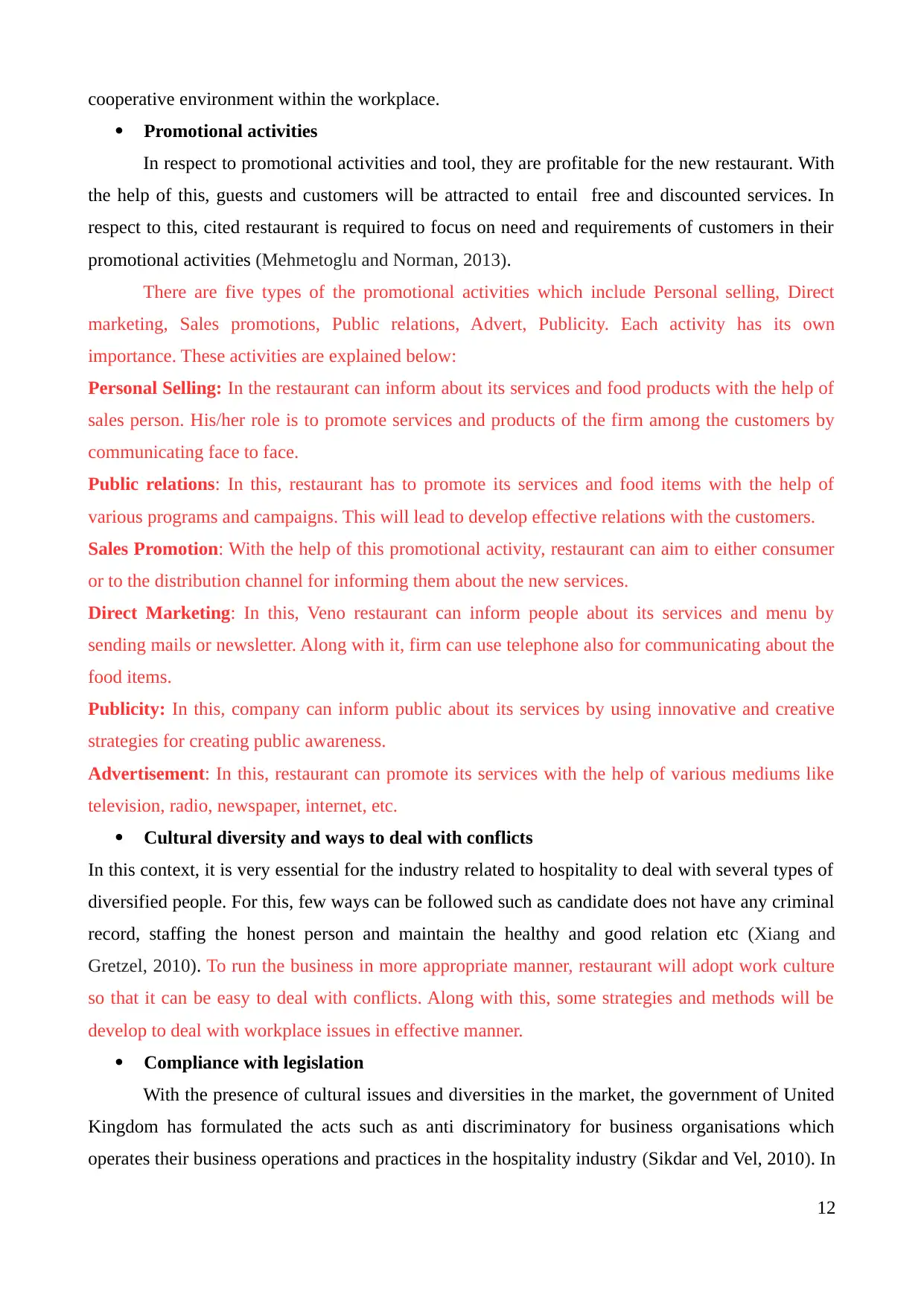
cooperative environment within the workplace.
Promotional activities
In respect to promotional activities and tool, they are profitable for the new restaurant. With
the help of this, guests and customers will be attracted to entail free and discounted services. In
respect to this, cited restaurant is required to focus on need and requirements of customers in their
promotional activities (Mehmetoglu and Norman, 2013).
There are five types of the promotional activities which include Personal selling, Direct
marketing, Sales promotions, Public relations, Advert, Publicity. Each activity has its own
importance. These activities are explained below:
Personal Selling: In the restaurant can inform about its services and food products with the help of
sales person. His/her role is to promote services and products of the firm among the customers by
communicating face to face.
Public relations: In this, restaurant has to promote its services and food items with the help of
various programs and campaigns. This will lead to develop effective relations with the customers.
Sales Promotion: With the help of this promotional activity, restaurant can aim to either consumer
or to the distribution channel for informing them about the new services.
Direct Marketing: In this, Veno restaurant can inform people about its services and menu by
sending mails or newsletter. Along with it, firm can use telephone also for communicating about the
food items.
Publicity: In this, company can inform public about its services by using innovative and creative
strategies for creating public awareness.
Advertisement: In this, restaurant can promote its services with the help of various mediums like
television, radio, newspaper, internet, etc.
Cultural diversity and ways to deal with conflicts
In this context, it is very essential for the industry related to hospitality to deal with several types of
diversified people. For this, few ways can be followed such as candidate does not have any criminal
record, staffing the honest person and maintain the healthy and good relation etc (Xiang and
Gretzel, 2010). To run the business in more appropriate manner, restaurant will adopt work culture
so that it can be easy to deal with conflicts. Along with this, some strategies and methods will be
develop to deal with workplace issues in effective manner.
Compliance with legislation
With the presence of cultural issues and diversities in the market, the government of United
Kingdom has formulated the acts such as anti discriminatory for business organisations which
operates their business operations and practices in the hospitality industry (Sikdar and Vel, 2010). In
12
Promotional activities
In respect to promotional activities and tool, they are profitable for the new restaurant. With
the help of this, guests and customers will be attracted to entail free and discounted services. In
respect to this, cited restaurant is required to focus on need and requirements of customers in their
promotional activities (Mehmetoglu and Norman, 2013).
There are five types of the promotional activities which include Personal selling, Direct
marketing, Sales promotions, Public relations, Advert, Publicity. Each activity has its own
importance. These activities are explained below:
Personal Selling: In the restaurant can inform about its services and food products with the help of
sales person. His/her role is to promote services and products of the firm among the customers by
communicating face to face.
Public relations: In this, restaurant has to promote its services and food items with the help of
various programs and campaigns. This will lead to develop effective relations with the customers.
Sales Promotion: With the help of this promotional activity, restaurant can aim to either consumer
or to the distribution channel for informing them about the new services.
Direct Marketing: In this, Veno restaurant can inform people about its services and menu by
sending mails or newsletter. Along with it, firm can use telephone also for communicating about the
food items.
Publicity: In this, company can inform public about its services by using innovative and creative
strategies for creating public awareness.
Advertisement: In this, restaurant can promote its services with the help of various mediums like
television, radio, newspaper, internet, etc.
Cultural diversity and ways to deal with conflicts
In this context, it is very essential for the industry related to hospitality to deal with several types of
diversified people. For this, few ways can be followed such as candidate does not have any criminal
record, staffing the honest person and maintain the healthy and good relation etc (Xiang and
Gretzel, 2010). To run the business in more appropriate manner, restaurant will adopt work culture
so that it can be easy to deal with conflicts. Along with this, some strategies and methods will be
develop to deal with workplace issues in effective manner.
Compliance with legislation
With the presence of cultural issues and diversities in the market, the government of United
Kingdom has formulated the acts such as anti discriminatory for business organisations which
operates their business operations and practices in the hospitality industry (Sikdar and Vel, 2010). In
12
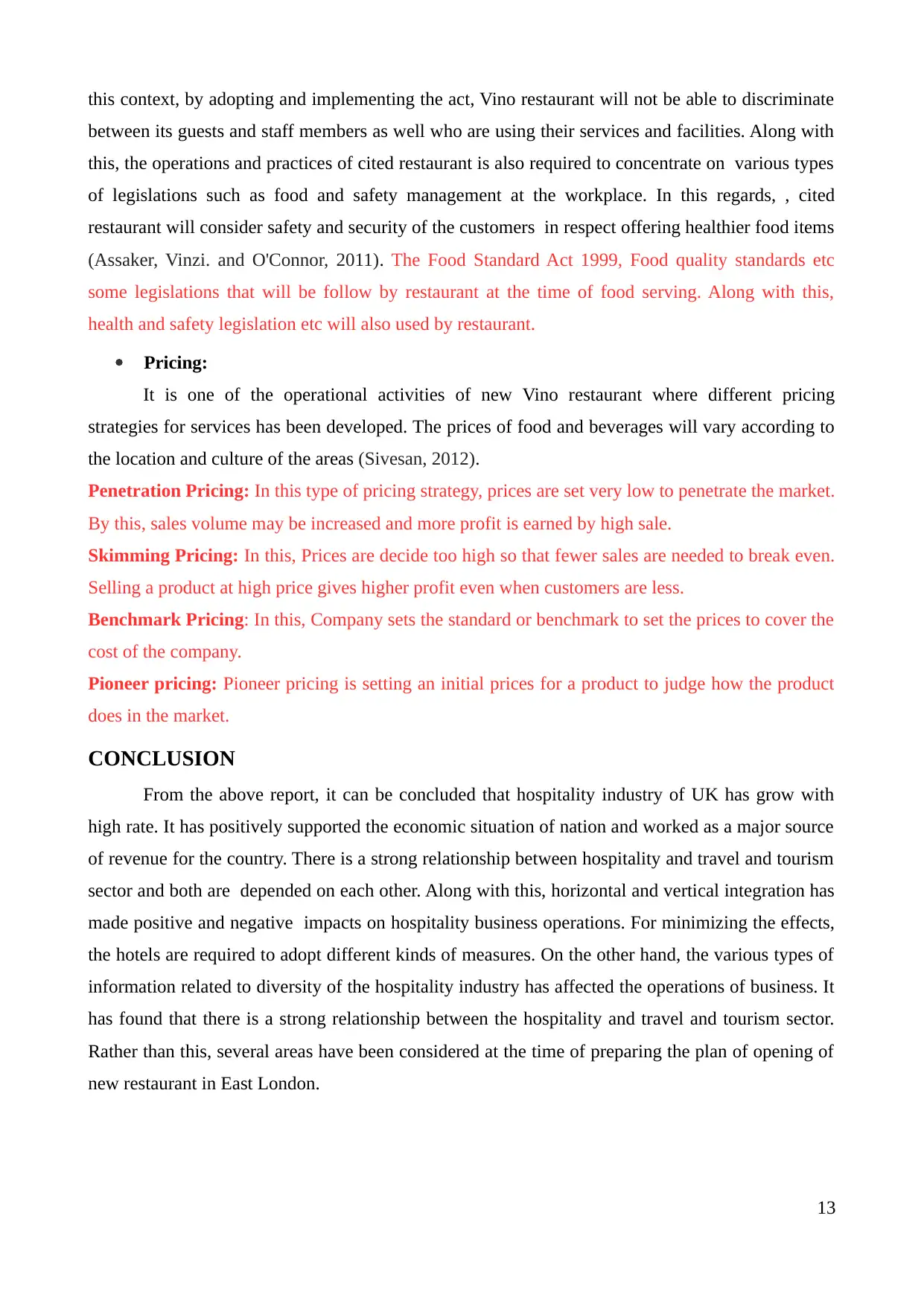
this context, by adopting and implementing the act, Vino restaurant will not be able to discriminate
between its guests and staff members as well who are using their services and facilities. Along with
this, the operations and practices of cited restaurant is also required to concentrate on various types
of legislations such as food and safety management at the workplace. In this regards, , cited
restaurant will consider safety and security of the customers in respect offering healthier food items
(Assaker, Vinzi. and O'Connor, 2011). The Food Standard Act 1999, Food quality standards etc
some legislations that will be follow by restaurant at the time of food serving. Along with this,
health and safety legislation etc will also used by restaurant.
Pricing:
It is one of the operational activities of new Vino restaurant where different pricing
strategies for services has been developed. The prices of food and beverages will vary according to
the location and culture of the areas (Sivesan, 2012).
Penetration Pricing: In this type of pricing strategy, prices are set very low to penetrate the market.
By this, sales volume may be increased and more profit is earned by high sale.
Skimming Pricing: In this, Prices are decide too high so that fewer sales are needed to break even.
Selling a product at high price gives higher profit even when customers are less.
Benchmark Pricing: In this, Company sets the standard or benchmark to set the prices to cover the
cost of the company.
Pioneer pricing: Pioneer pricing is setting an initial prices for a product to judge how the product
does in the market.
CONCLUSION
From the above report, it can be concluded that hospitality industry of UK has grow with
high rate. It has positively supported the economic situation of nation and worked as a major source
of revenue for the country. There is a strong relationship between hospitality and travel and tourism
sector and both are depended on each other. Along with this, horizontal and vertical integration has
made positive and negative impacts on hospitality business operations. For minimizing the effects,
the hotels are required to adopt different kinds of measures. On the other hand, the various types of
information related to diversity of the hospitality industry has affected the operations of business. It
has found that there is a strong relationship between the hospitality and travel and tourism sector.
Rather than this, several areas have been considered at the time of preparing the plan of opening of
new restaurant in East London.
13
between its guests and staff members as well who are using their services and facilities. Along with
this, the operations and practices of cited restaurant is also required to concentrate on various types
of legislations such as food and safety management at the workplace. In this regards, , cited
restaurant will consider safety and security of the customers in respect offering healthier food items
(Assaker, Vinzi. and O'Connor, 2011). The Food Standard Act 1999, Food quality standards etc
some legislations that will be follow by restaurant at the time of food serving. Along with this,
health and safety legislation etc will also used by restaurant.
Pricing:
It is one of the operational activities of new Vino restaurant where different pricing
strategies for services has been developed. The prices of food and beverages will vary according to
the location and culture of the areas (Sivesan, 2012).
Penetration Pricing: In this type of pricing strategy, prices are set very low to penetrate the market.
By this, sales volume may be increased and more profit is earned by high sale.
Skimming Pricing: In this, Prices are decide too high so that fewer sales are needed to break even.
Selling a product at high price gives higher profit even when customers are less.
Benchmark Pricing: In this, Company sets the standard or benchmark to set the prices to cover the
cost of the company.
Pioneer pricing: Pioneer pricing is setting an initial prices for a product to judge how the product
does in the market.
CONCLUSION
From the above report, it can be concluded that hospitality industry of UK has grow with
high rate. It has positively supported the economic situation of nation and worked as a major source
of revenue for the country. There is a strong relationship between hospitality and travel and tourism
sector and both are depended on each other. Along with this, horizontal and vertical integration has
made positive and negative impacts on hospitality business operations. For minimizing the effects,
the hotels are required to adopt different kinds of measures. On the other hand, the various types of
information related to diversity of the hospitality industry has affected the operations of business. It
has found that there is a strong relationship between the hospitality and travel and tourism sector.
Rather than this, several areas have been considered at the time of preparing the plan of opening of
new restaurant in East London.
13
Paraphrase This Document
Need a fresh take? Get an instant paraphrase of this document with our AI Paraphraser
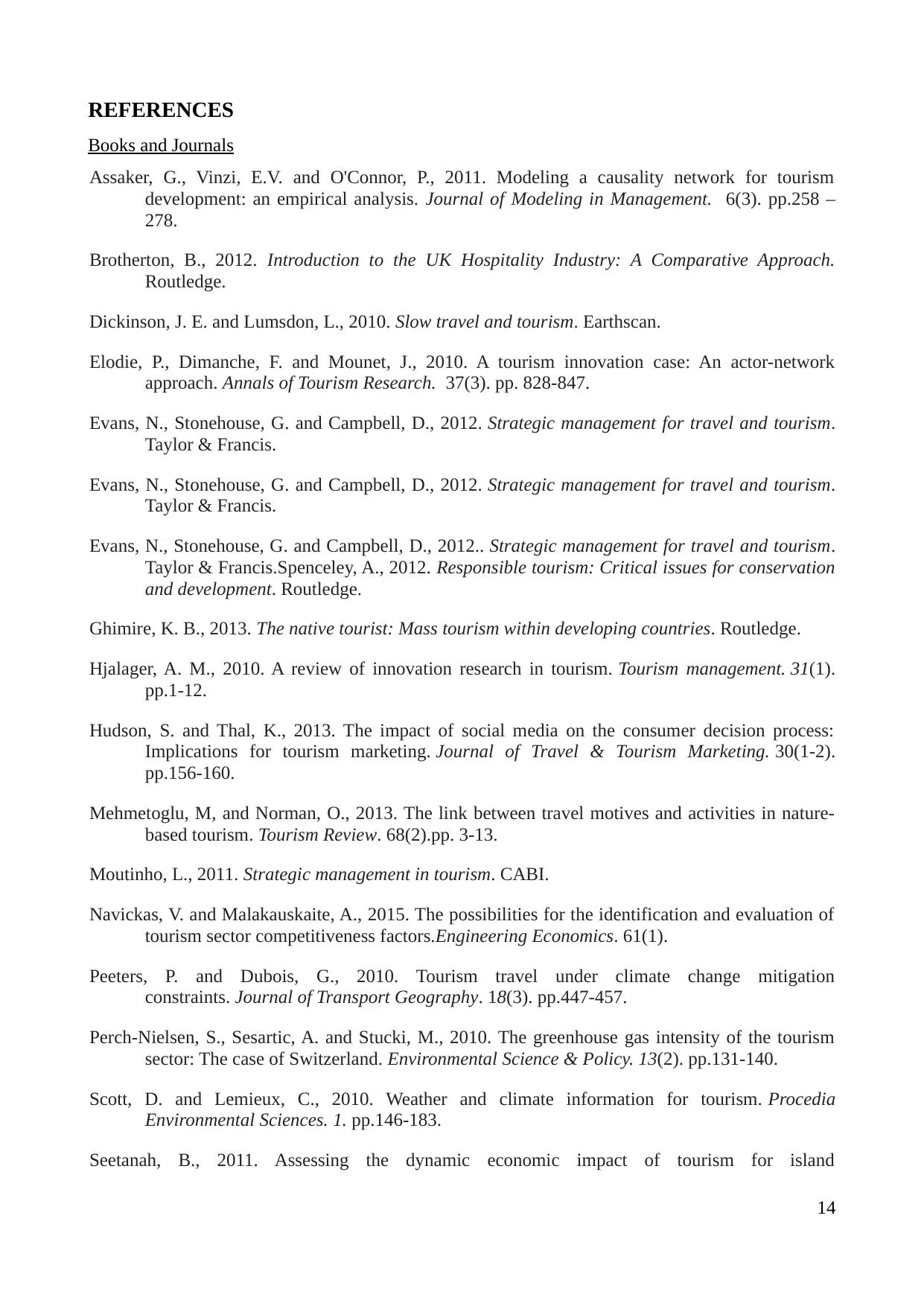
REFERENCES
Books and Journals
Assaker, G., Vinzi, E.V. and O'Connor, P., 2011. Modeling a causality network for tourism
development: an empirical analysis. Journal of Modeling in Management. 6(3). pp.258 –
278.
Brotherton, B., 2012. Introduction to the UK Hospitality Industry: A Comparative Approach.
Routledge.
Dickinson, J. E. and Lumsdon, L., 2010. Slow travel and tourism. Earthscan.
Elodie, P., Dimanche, F. and Mounet, J., 2010. A tourism innovation case: An actor-network
approach. Annals of Tourism Research. 37(3). pp. 828-847.
Evans, N., Stonehouse, G. and Campbell, D., 2012. Strategic management for travel and tourism.
Taylor & Francis.
Evans, N., Stonehouse, G. and Campbell, D., 2012. Strategic management for travel and tourism.
Taylor & Francis.
Evans, N., Stonehouse, G. and Campbell, D., 2012.. Strategic management for travel and tourism.
Taylor & Francis.Spenceley, A., 2012. Responsible tourism: Critical issues for conservation
and development. Routledge.
Ghimire, K. B., 2013. The native tourist: Mass tourism within developing countries. Routledge.
Hjalager, A. M., 2010. A review of innovation research in tourism. Tourism management. 31(1).
pp.1-12.
Hudson, S. and Thal, K., 2013. The impact of social media on the consumer decision process:
Implications for tourism marketing. Journal of Travel & Tourism Marketing. 30(1-2).
pp.156-160.
Mehmetoglu, M, and Norman, O., 2013. The link between travel motives and activities in nature-
based tourism. Tourism Review. 68(2).pp. 3-13.
Moutinho, L., 2011. Strategic management in tourism. CABI.
Navickas, V. and Malakauskaite, A., 2015. The possibilities for the identification and evaluation of
tourism sector competitiveness factors.Engineering Economics. 61(1).
Peeters, P. and Dubois, G., 2010. Tourism travel under climate change mitigation
constraints. Journal of Transport Geography. 18(3). pp.447-457.
Perch-Nielsen, S., Sesartic, A. and Stucki, M., 2010. The greenhouse gas intensity of the tourism
sector: The case of Switzerland. Environmental Science & Policy. 13(2). pp.131-140.
Scott, D. and Lemieux, C., 2010. Weather and climate information for tourism. Procedia
Environmental Sciences. 1. pp.146-183.
Seetanah, B., 2011. Assessing the dynamic economic impact of tourism for island
14
Books and Journals
Assaker, G., Vinzi, E.V. and O'Connor, P., 2011. Modeling a causality network for tourism
development: an empirical analysis. Journal of Modeling in Management. 6(3). pp.258 –
278.
Brotherton, B., 2012. Introduction to the UK Hospitality Industry: A Comparative Approach.
Routledge.
Dickinson, J. E. and Lumsdon, L., 2010. Slow travel and tourism. Earthscan.
Elodie, P., Dimanche, F. and Mounet, J., 2010. A tourism innovation case: An actor-network
approach. Annals of Tourism Research. 37(3). pp. 828-847.
Evans, N., Stonehouse, G. and Campbell, D., 2012. Strategic management for travel and tourism.
Taylor & Francis.
Evans, N., Stonehouse, G. and Campbell, D., 2012. Strategic management for travel and tourism.
Taylor & Francis.
Evans, N., Stonehouse, G. and Campbell, D., 2012.. Strategic management for travel and tourism.
Taylor & Francis.Spenceley, A., 2012. Responsible tourism: Critical issues for conservation
and development. Routledge.
Ghimire, K. B., 2013. The native tourist: Mass tourism within developing countries. Routledge.
Hjalager, A. M., 2010. A review of innovation research in tourism. Tourism management. 31(1).
pp.1-12.
Hudson, S. and Thal, K., 2013. The impact of social media on the consumer decision process:
Implications for tourism marketing. Journal of Travel & Tourism Marketing. 30(1-2).
pp.156-160.
Mehmetoglu, M, and Norman, O., 2013. The link between travel motives and activities in nature-
based tourism. Tourism Review. 68(2).pp. 3-13.
Moutinho, L., 2011. Strategic management in tourism. CABI.
Navickas, V. and Malakauskaite, A., 2015. The possibilities for the identification and evaluation of
tourism sector competitiveness factors.Engineering Economics. 61(1).
Peeters, P. and Dubois, G., 2010. Tourism travel under climate change mitigation
constraints. Journal of Transport Geography. 18(3). pp.447-457.
Perch-Nielsen, S., Sesartic, A. and Stucki, M., 2010. The greenhouse gas intensity of the tourism
sector: The case of Switzerland. Environmental Science & Policy. 13(2). pp.131-140.
Scott, D. and Lemieux, C., 2010. Weather and climate information for tourism. Procedia
Environmental Sciences. 1. pp.146-183.
Seetanah, B., 2011. Assessing the dynamic economic impact of tourism for island
14
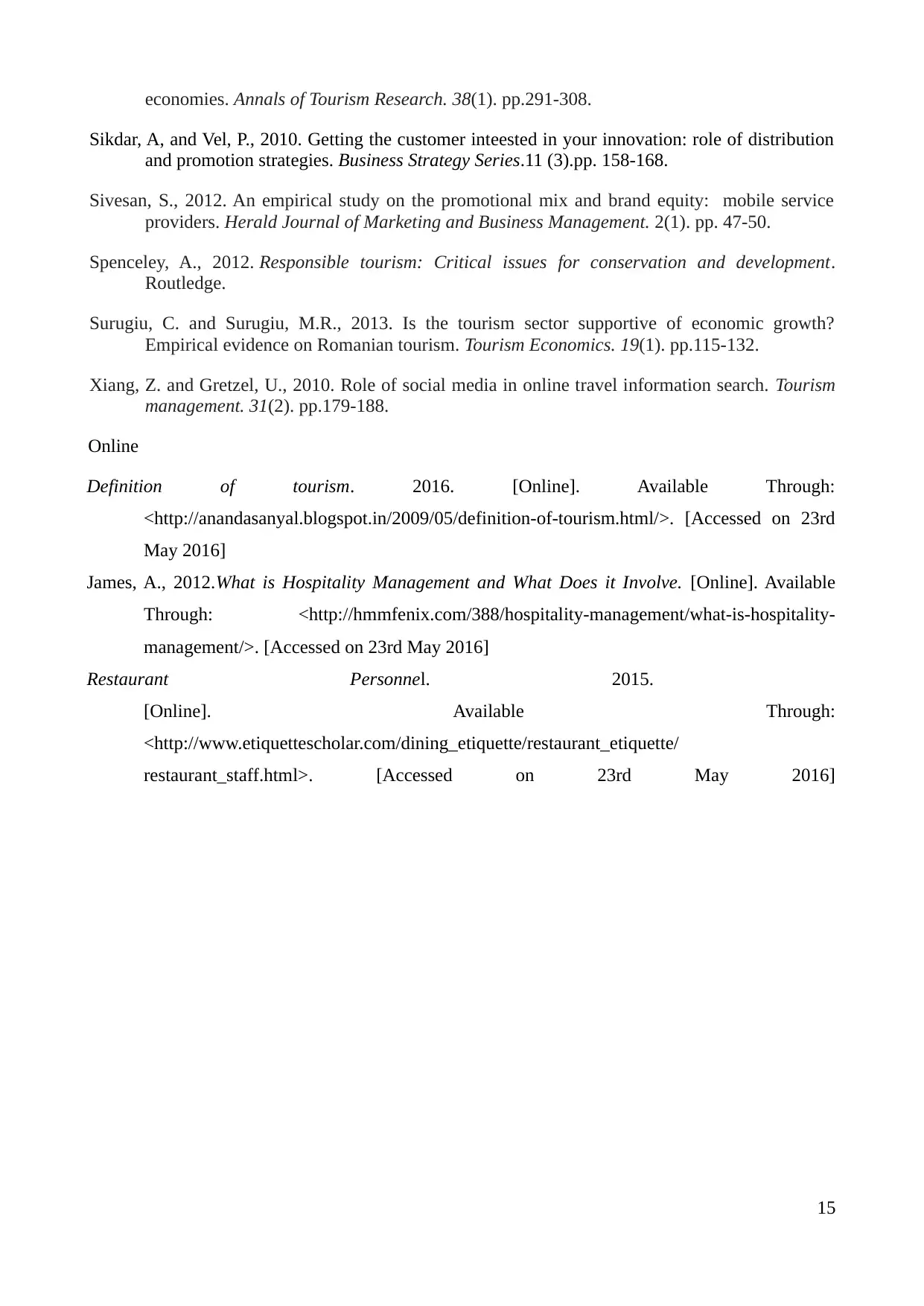
economies. Annals of Tourism Research. 38(1). pp.291-308.
Sikdar, A, and Vel, P., 2010. Getting the customer inteested in your innovation: role of distribution
and promotion strategies. Business Strategy Series.11 (3).pp. 158-168.
Sivesan, S., 2012. An empirical study on the promotional mix and brand equity: mobile service
providers. Herald Journal of Marketing and Business Management. 2(1). pp. 47-50.
Spenceley, A., 2012. Responsible tourism: Critical issues for conservation and development.
Routledge.
Surugiu, C. and Surugiu, M.R., 2013. Is the tourism sector supportive of economic growth?
Empirical evidence on Romanian tourism. Tourism Economics. 19(1). pp.115-132.
Xiang, Z. and Gretzel, U., 2010. Role of social media in online travel information search. Tourism
management. 31(2). pp.179-188.
Online
Definition of tourism. 2016. [Online]. Available Through:
<http://anandasanyal.blogspot.in/2009/05/definition-of-tourism.html/>. [Accessed on 23rd
May 2016]
James, A., 2012.What is Hospitality Management and What Does it Involve. [Online]. Available
Through: <http://hmmfenix.com/388/hospitality-management/what-is-hospitality-
management/>. [Accessed on 23rd May 2016]
Restaurant Personnel. 2015.
[Online]. Available Through:
<http://www.etiquettescholar.com/dining_etiquette/restaurant_etiquette/
restaurant_staff.html>. [Accessed on 23rd May 2016]
15
Sikdar, A, and Vel, P., 2010. Getting the customer inteested in your innovation: role of distribution
and promotion strategies. Business Strategy Series.11 (3).pp. 158-168.
Sivesan, S., 2012. An empirical study on the promotional mix and brand equity: mobile service
providers. Herald Journal of Marketing and Business Management. 2(1). pp. 47-50.
Spenceley, A., 2012. Responsible tourism: Critical issues for conservation and development.
Routledge.
Surugiu, C. and Surugiu, M.R., 2013. Is the tourism sector supportive of economic growth?
Empirical evidence on Romanian tourism. Tourism Economics. 19(1). pp.115-132.
Xiang, Z. and Gretzel, U., 2010. Role of social media in online travel information search. Tourism
management. 31(2). pp.179-188.
Online
Definition of tourism. 2016. [Online]. Available Through:
<http://anandasanyal.blogspot.in/2009/05/definition-of-tourism.html/>. [Accessed on 23rd
May 2016]
James, A., 2012.What is Hospitality Management and What Does it Involve. [Online]. Available
Through: <http://hmmfenix.com/388/hospitality-management/what-is-hospitality-
management/>. [Accessed on 23rd May 2016]
Restaurant Personnel. 2015.
[Online]. Available Through:
<http://www.etiquettescholar.com/dining_etiquette/restaurant_etiquette/
restaurant_staff.html>. [Accessed on 23rd May 2016]
15
1 out of 15
Related Documents
Your All-in-One AI-Powered Toolkit for Academic Success.
+13062052269
info@desklib.com
Available 24*7 on WhatsApp / Email
![[object Object]](/_next/static/media/star-bottom.7253800d.svg)
Unlock your academic potential
© 2024 | Zucol Services PVT LTD | All rights reserved.





